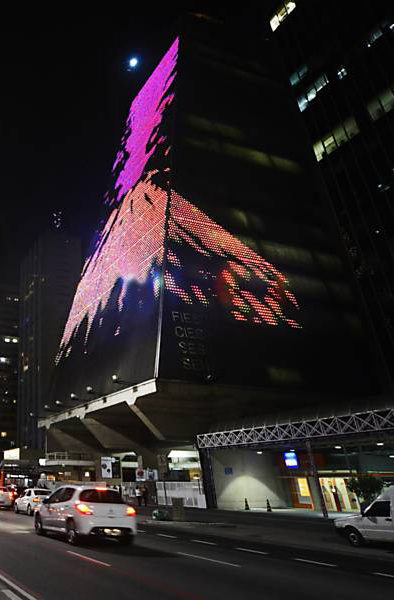
FILE LED SHOW 2014
Rozendaal Project
hotdoom
file festival

Rozendaal Project
hotdoom
file festival

1024 ARCHITECTURE
The project consists of a podium with a microphone installed on the sidewalk of the Paulista Avenue, where people could interact through the vocal conversion into musical notes. The 1024 architecture group elaborated a brand new algorithm for this project, which changes the graphic behaviors by means of sounds. Depending on the note sung, several parameters of the program, such as colors, shapes and density.
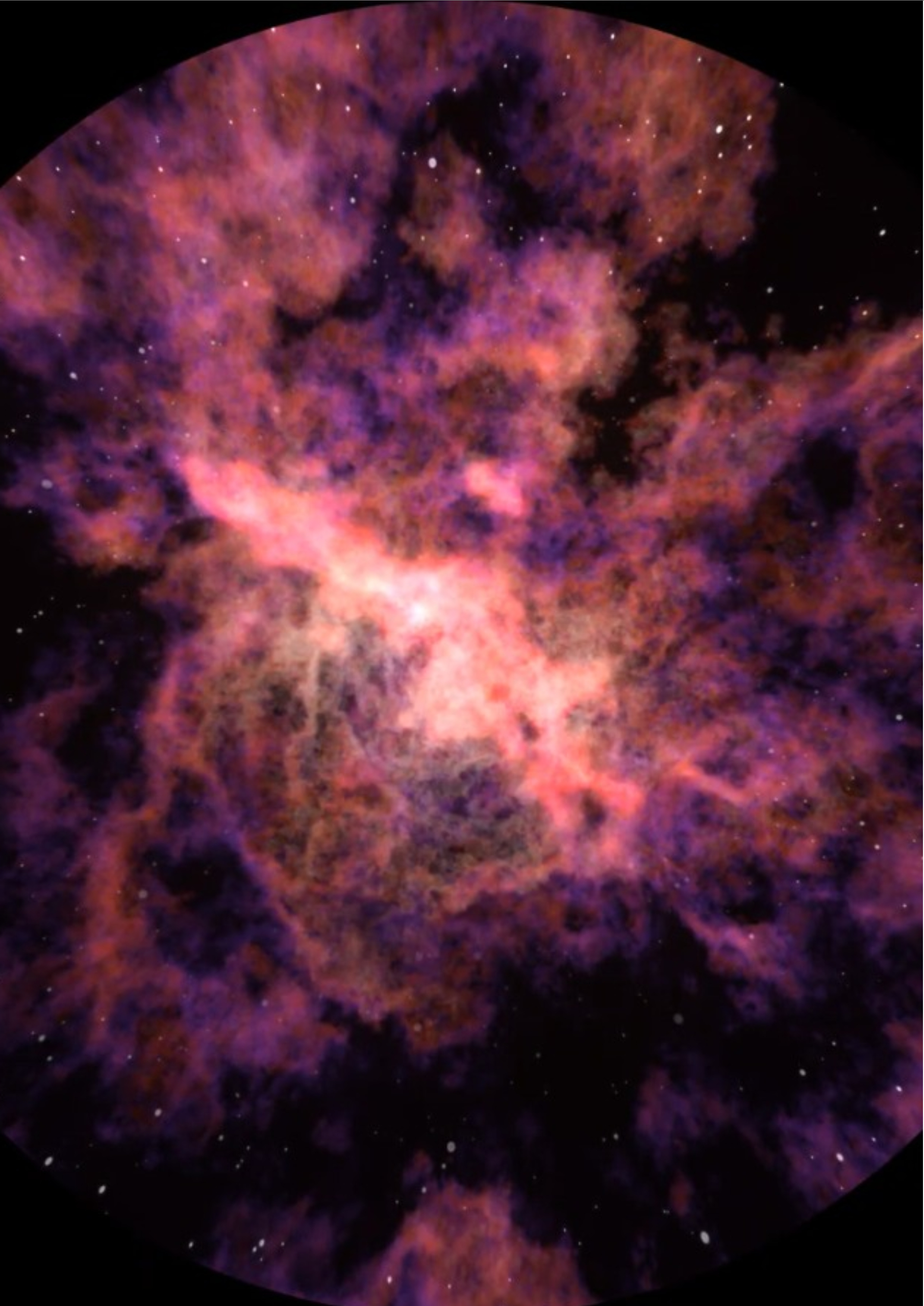
Jorge Bandera
FILE SÃO PAULO 2025: SYNTHETIKA – Arte e Tecnologia – Led Show
Festival Internacional de Linguagem Eletrônica
Desconexion – Colômbia
Desconexion explora a transformação da energia. A peça entrelaça perspectivas espirituais e científicas — fundamentadas na Lei da Conservação da Energia e na Teoria da Relatividade de Einstein. Simbolizando a metamorfose contínua da vida, a obra revela a eternidade da energia, onde o fim de cada ciclo marca um novo começo.
BIO
Jorge Bandera é designer multimídia e professor assistente na Universidad de los Andes, em Bogotá, Colômbia. Especialista em design, interatividade, animação e experiências imersivas, colaborou com instituições como o Google, o Teatro Mayor e o Ministério da Cultura. É também um defensor da cocriação interdisciplinar no campo da educação.
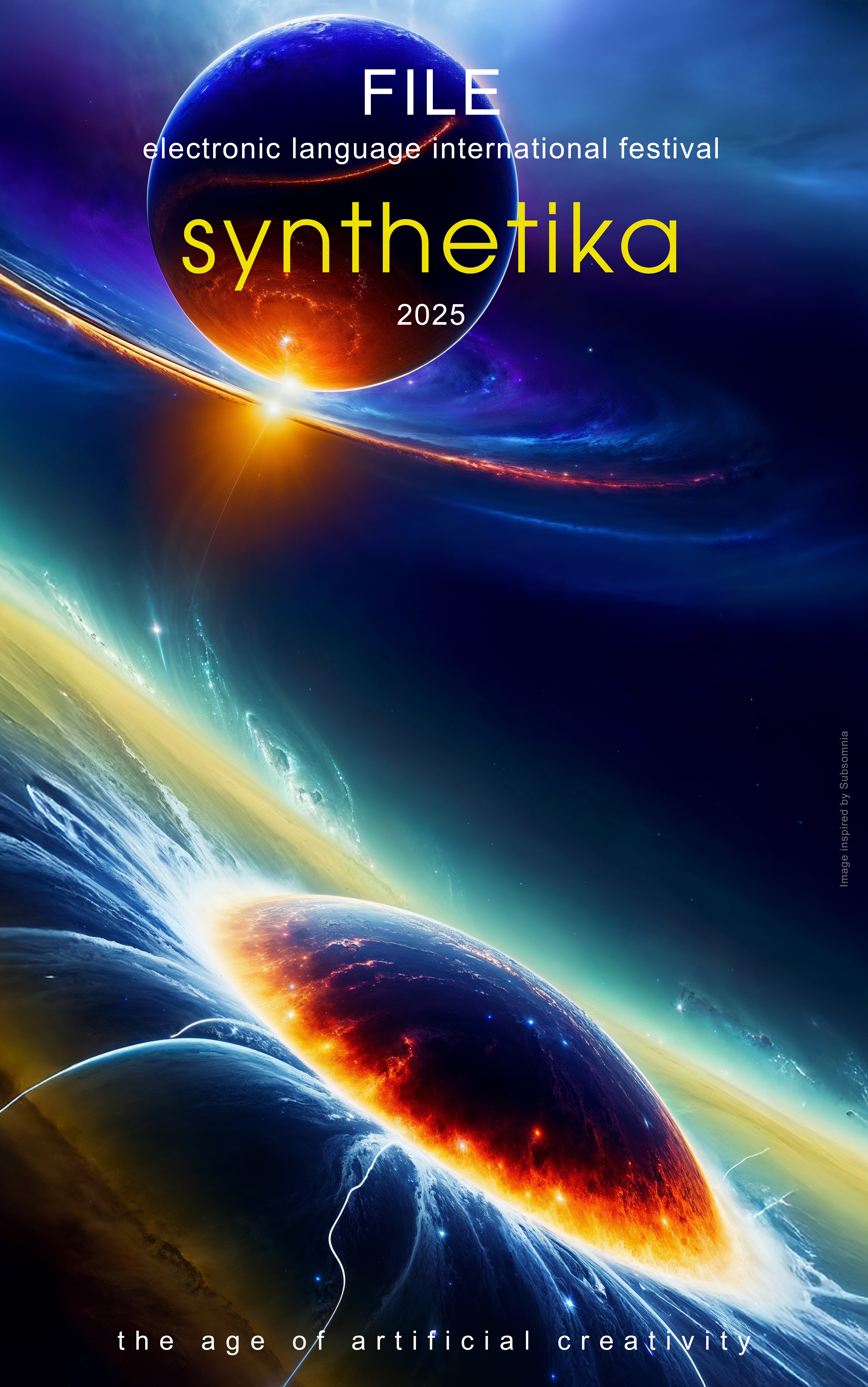
Unlike Hegel, who called the set of ideas of a given era the “spirit of the times” (Zeitgeist), we could call our era “Zeitsynthetik” (the time of the synthetic). In the classical period, art was inseparable from religion, whose essence was spirituality; in modernity, spirituality was replaced by the ideologies of grand narratives (capitalism and socialism). The classical arts invented poetics and aesthetics: the beautiful and the sublime. Modern art invented the avant-garde that proposed to be revolutionary, its driving force was the dialectic of the new without the old, and on the other hand, postmodernists mixed everything with everything, including the old with the new. Today we live in the era of synthetic technologies, the era of disruptive technologies. In which the new of modernity is no longer sufficient or surprising. Syntheticity is the new vector: synthetic algorithms; synthetic virtual realities; synthetic intelligences. The driving force behind synthetic art is: 1) the fusion of new art and technological innovation, and 2) the inter-creativity between the artist and artificial creativity. Prompt engineers strategically simulate personas for AIs in order to move away from triviality and thus obtain more creative results. Synthetic intelligences are no longer just instruments, but partners of artists in the construction of a creative and innovative symbiosis.
Art and culture are going through a moment in which creativity ceases to be just human, it becomes artificial; syntheticity thus prospects a post-culture, a new FORM: the form SYNTHETIKA.
Ricardo Barreto
Curator and co-founder of FILE

FILE 2024
QUBIT AI | quantum & synthetic ai
Electronic Language International Festival
July 3rd to August 25th
Tuesday to Sunday, 10am – 8pm
FIESP Cultural Center
Design: André Lenz
Image: Iskarioto Dystopian AI Films – Athena
QUBIT AI
In its 25 years of existence, the International Electronic Language Festival (FILE) is an internationally renowned Brazilian project that since 2000 has explored the intersection between art and technology. With more than two decades of history, the festival stands out for fostering exhibition spaces and debate about artistic innovations driven by disruptive and innovative technologies, inviting the public to get involved with experimental forms of art that challenge the boundaries of conventionality. Currently, two of these technologies stand out in the contemporary scenario: the accelerated development of quantum computing and artificial intelligence corroborated by synthetic data.
Quantum computing, an emerging revolution in the technological field, offers a new range of creative possibilities for contemporary artists. This new era allows the exploration of unprecedented frontiers through a new computational format that consists mainly of quantum superposition and entanglement, a new field of exploration for synthetic computer science, as well as for the arts in general; on the other hand, artificial intelligence, fueled by synthetic data, offers artists a new way of making and understanding art, opening up space for new forms, concepts and artistic expressions.
Entitled QUBIT AI, the exhibition delves into this unexplored territory presenting a selection of works of art resulting from the connection between artistic creation and technology, proposing a theoretical reflection on what the interrelationship between quantum computers and synthetic artificial intelligence will be.
Visitors will be invited to experience immersive installations, experimental videos, digital sculptures and other forms of interactive art, which intertwine reality and imagination. The exhibition encourages reflections on the influence of technology on art and contemporary society, while at the same time providing an environment to compare already established technological arts (analog and digital) with the possible futures of art in the synthetic era, enhanced by quantum computing. The QUBIT AI exhibition at FILE SP 2024 transcends the mere presentation of works of art; it is a journey to the limits of human creativity, driven by the convergence of art, science and technology.
Ricardo Barreto and Paula Perissinotto
co-organizers and curators of FILE
International Electronic Language Festival

FILE 2024
QUBIT AI | quantum & synthetic ai
Electronic Language International Festival
July 3rd to August 25th
Tuesday to Sunday, 10am – 8pm
FIESP Cultural Center
Design: André Lenz
Image: Iskarioto Dystopian AI Films – Athena
QUBIT AI
In its 25 years of existence, the International Electronic Language Festival (FILE) is an internationally renowned Brazilian project that since 2000 has explored the intersection between art and technology. With more than two decades of history, the festival stands out for fostering exhibition spaces and debate about artistic innovations driven by disruptive and innovative technologies, inviting the public to get involved with experimental forms of art that challenge the boundaries of conventionality. Currently, two of these technologies stand out in the contemporary scenario: the accelerated development of quantum computing and artificial intelligence corroborated by synthetic data.
Quantum computing, an emerging revolution in the technological field, offers a new range of creative possibilities for contemporary artists. This new era allows the exploration of unprecedented frontiers through a new computational format that consists mainly of quantum superposition and entanglement, a new field of exploration for synthetic computer science, as well as for the arts in general; on the other hand, artificial intelligence, fueled by synthetic data, offers artists a new way of making and understanding art, opening up space for new forms, concepts and artistic expressions.
Entitled QUBIT AI, the exhibition delves into this unexplored territory presenting a selection of works of art resulting from the connection between artistic creation and technology, proposing a theoretical reflection on what the interrelationship between quantum computers and synthetic artificial intelligence will be.
Visitors will be invited to experience immersive installations, experimental videos, digital sculptures and other forms of interactive art, which intertwine reality and imagination. The exhibition encourages reflections on the influence of technology on art and contemporary society, while at the same time providing an environment to compare already established technological arts (analog and digital) with the possible futures of art in the synthetic era, enhanced by quantum computing. The QUBIT AI exhibition at FILE SP 2024 transcends the mere presentation of works of art; it is a journey to the limits of human creativity, driven by the convergence of art, science and technology.
Ricardo Barreto and Paula Perissinotto
co-organizers and curators of FILE
International Electronic Language Festival

FILE 2024
QUBIT AI | quantum & synthetic ai
Electronic Language International Festival
July 3rd to August 25th
Tuesday to Sunday, 10am – 8pm
FIESP Cultural Center
Design: André Lenz
Image: Iskarioto Dystopian AI Films – Athena
QUBIT AI
In its 25 years of existence, the International Electronic Language Festival (FILE) is an internationally renowned Brazilian project that since 2000 has explored the intersection between art and technology. With more than two decades of history, the festival stands out for fostering exhibition spaces and debate about artistic innovations driven by disruptive and innovative technologies, inviting the public to get involved with experimental forms of art that challenge the boundaries of conventionality. Currently, two of these technologies stand out in the contemporary scenario: the accelerated development of quantum computing and artificial intelligence corroborated by synthetic data.
Quantum computing, an emerging revolution in the technological field, offers a new range of creative possibilities for contemporary artists. This new era allows the exploration of unprecedented frontiers through a new computational format that consists mainly of quantum superposition and entanglement, a new field of exploration for synthetic computer science, as well as for the arts in general; on the other hand, artificial intelligence, fueled by synthetic data, offers artists a new way of making and understanding art, opening up space for new forms, concepts and artistic expressions.
Entitled QUBIT AI, the exhibition delves into this unexplored territory presenting a selection of works of art resulting from the connection between artistic creation and technology, proposing a theoretical reflection on what the interrelationship between quantum computers and synthetic artificial intelligence will be.
Visitors will be invited to experience immersive installations, experimental videos, digital sculptures and other forms of interactive art, which intertwine reality and imagination. The exhibition encourages reflections on the influence of technology on art and contemporary society, while at the same time providing an environment to compare already established technological arts (analog and digital) with the possible futures of art in the synthetic era, enhanced by quantum computing. The QUBIT AI exhibition at FILE SP 2024 transcends the mere presentation of works of art; it is a journey to the limits of human creativity, driven by the convergence of art, science and technology.
Ricardo Barreto and Paula Perissinotto
co-organizers and curators of FILE
International Electronic Language Festival

The Call for Entries to participate in FILE – Electronic Language International Festival’s projects in 2024 is now open. The festival seeks original artworks in Art and Technology, by Brazilian and international artists. Registration remains open until February 10th. Access the registration form.
FILE is a non-profit cultural organization that has propagated creation and experimentation in Art and Technology through exhibitions, events and publications over 23 years. This call opens up the opportunity to participate in the 23rd. Edition of the Electronic Language International Festival, which is scheduled to take place at the FIESP Cultural Center, in São Paulo. The selected projects will also be able to collaborate in parallel events in different states in Brazil.
Using the registration form, it is possible to send interactive installations, sound art, video art, robotics, animations, CGI videos, virtual realities, augmented realities, mobile art, games, gifs, internet art, lectures and workshops, among others. To participate in the LED SHOW programm, exhibited annually at the FIESP Digital Art Gallery, register using the form. Sign up!

saccade
OUCHHH STUDIO
Neuroscientific-Installation
We are invited to São Paulo for our vertical light and sound installation which will transform the facade of São Paulo’s one of the most important architecture which is Fiesp Led Building.
We started this project with the idea that Neuroscience and simultaneous movement of both eyes between two or more phases of fixation in the same direction algorithms, and we transform the high-resolution led screen into a media canvas which transformed into living architecture.
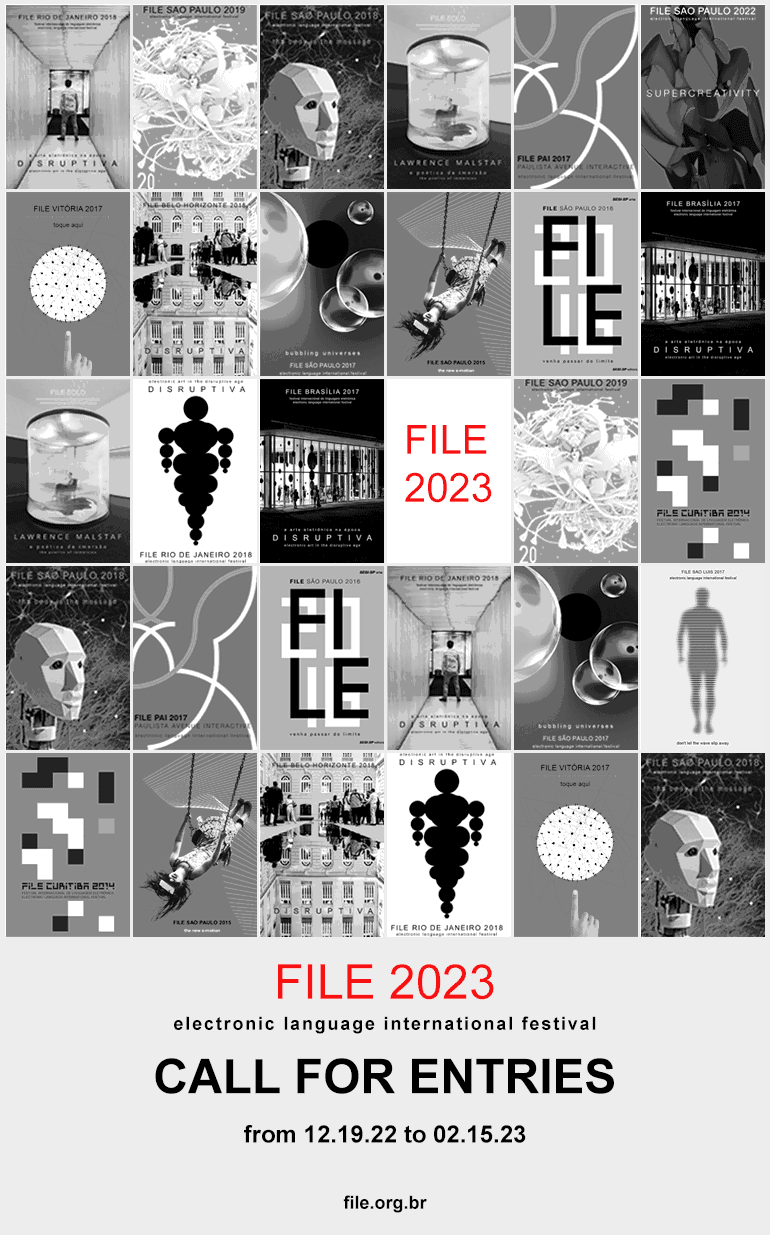
file 2023
Call for Entries
FILE – Electronic Language International Festival – is receiving proposals for authorial works and educational projects (talks and workshops) in Art and Technology, from Brazilian and international artists, who are interested in being part of our 2023 exhibitions. Applications will be open from December 19th to February 15th.This announcement opens the opportunity to participate in the 22nd. Edition of the Electronic Language International Festival, which is scheduled to take place at the FIESP Cultural Center, in São Paulo, from July 5th to August 27th. The selected projects will also be able to collaborate in parallel events in different states of Brazil, to be held in the same year of 2023.
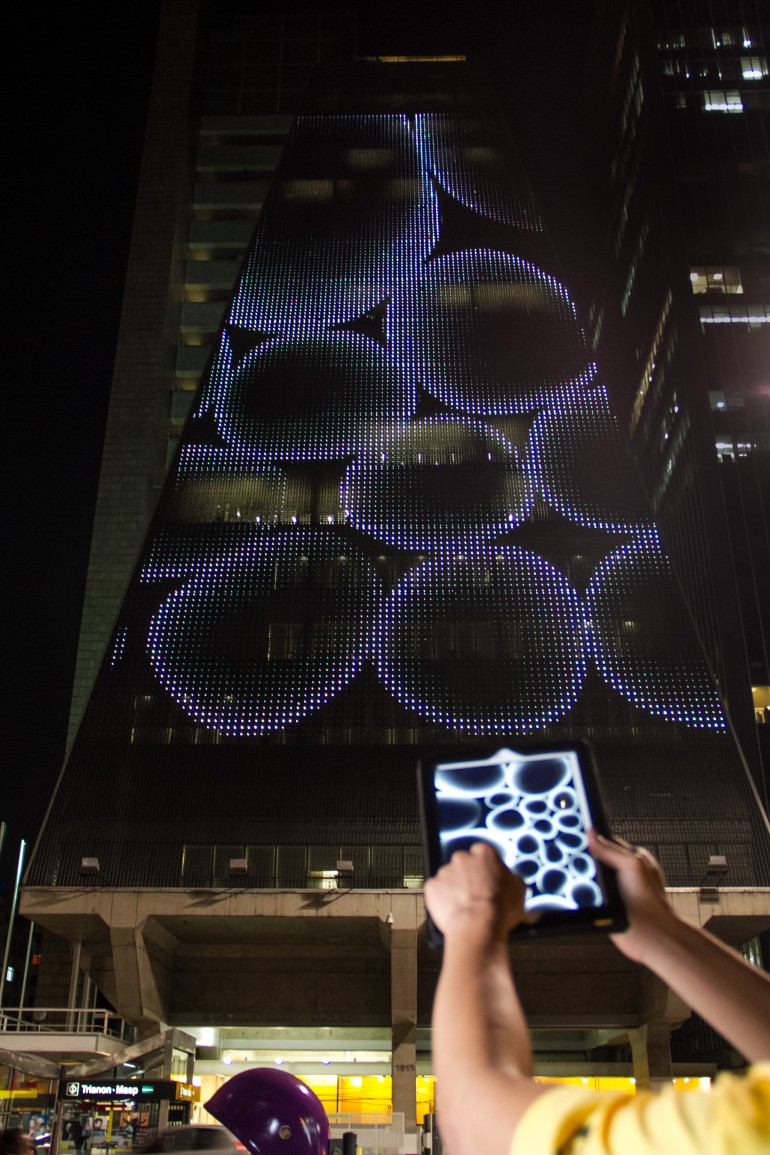
Rozendaal Project
thepersistenceofsadness
FILE LED SHOW
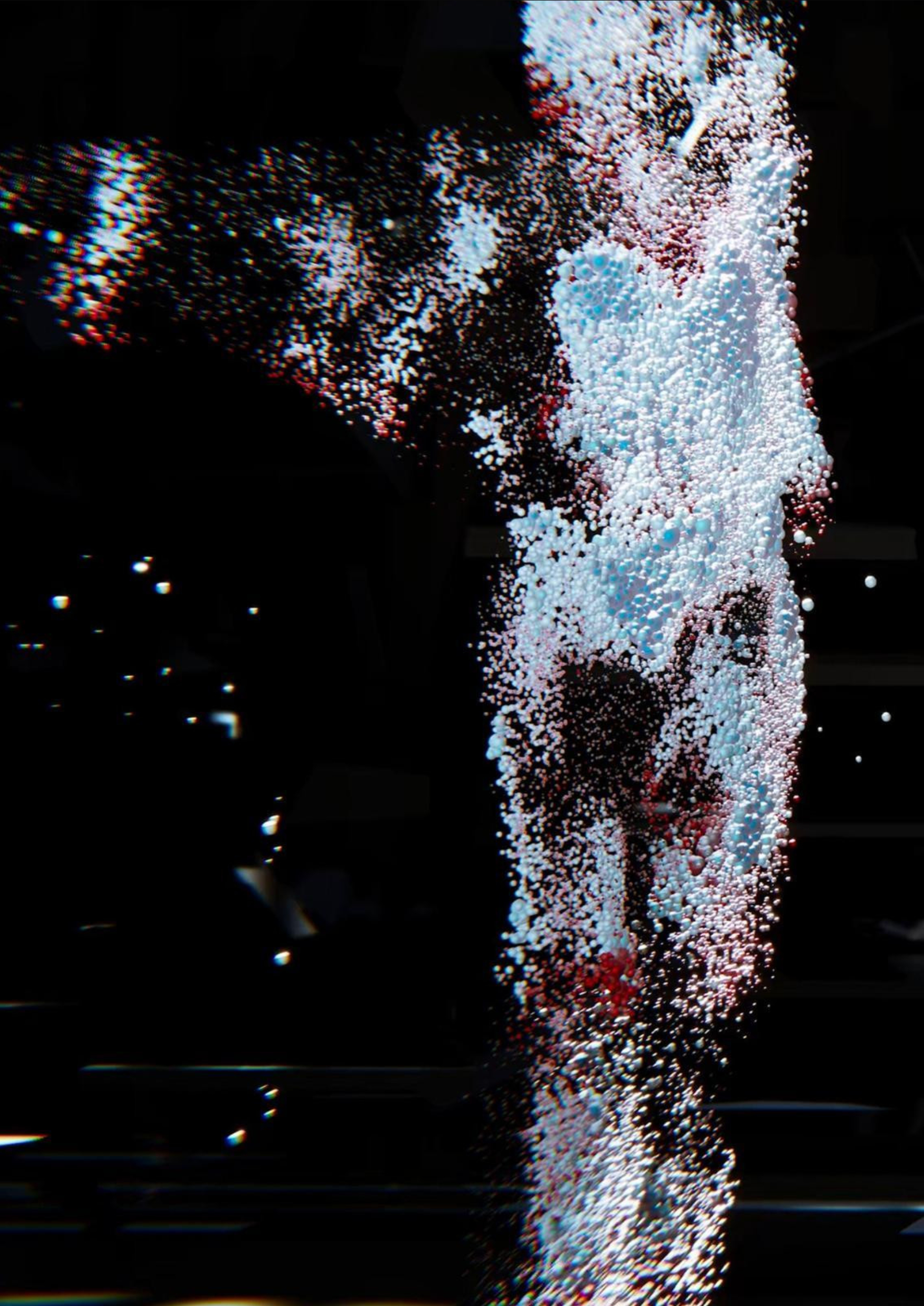
Flavia Mazzanti
FILE São Paulo 2025 | LED Show
Festival Internacional de Linguagem Eletrônica
Beyond My Skin – Brasil
Beyond My Skin é um projeto interdisciplinar apresentado na forma de instalação interativa, performance híbrida e experiência em realidade mista (MR), que explora a relação híbrida entre corpos humanos e suas representações digitais por meio do uso experimental de diferentes tecnologias e mídias imersivas. O projeto já foi exibido em diversos espaços, como o Deep Space 8K do Ars Electronica Center (Linz, Áustria).
BIO
Flavia Mazzanti é uma artista multimídia que vive e trabalha entre Viena e São Paulo. Sua obra explora conceitos artístico-filosóficos relacionados a pós-antropocentrismo, entrelaçamento, corpo e identidade, com o interesse de oferecer perspectivas alternativas sobre nós mesmos e nosso entorno. Seus trabalhos têm sido exibidos internacionalmente, incluindo em países como Áustria, Suíça, Alemanha e Japão.
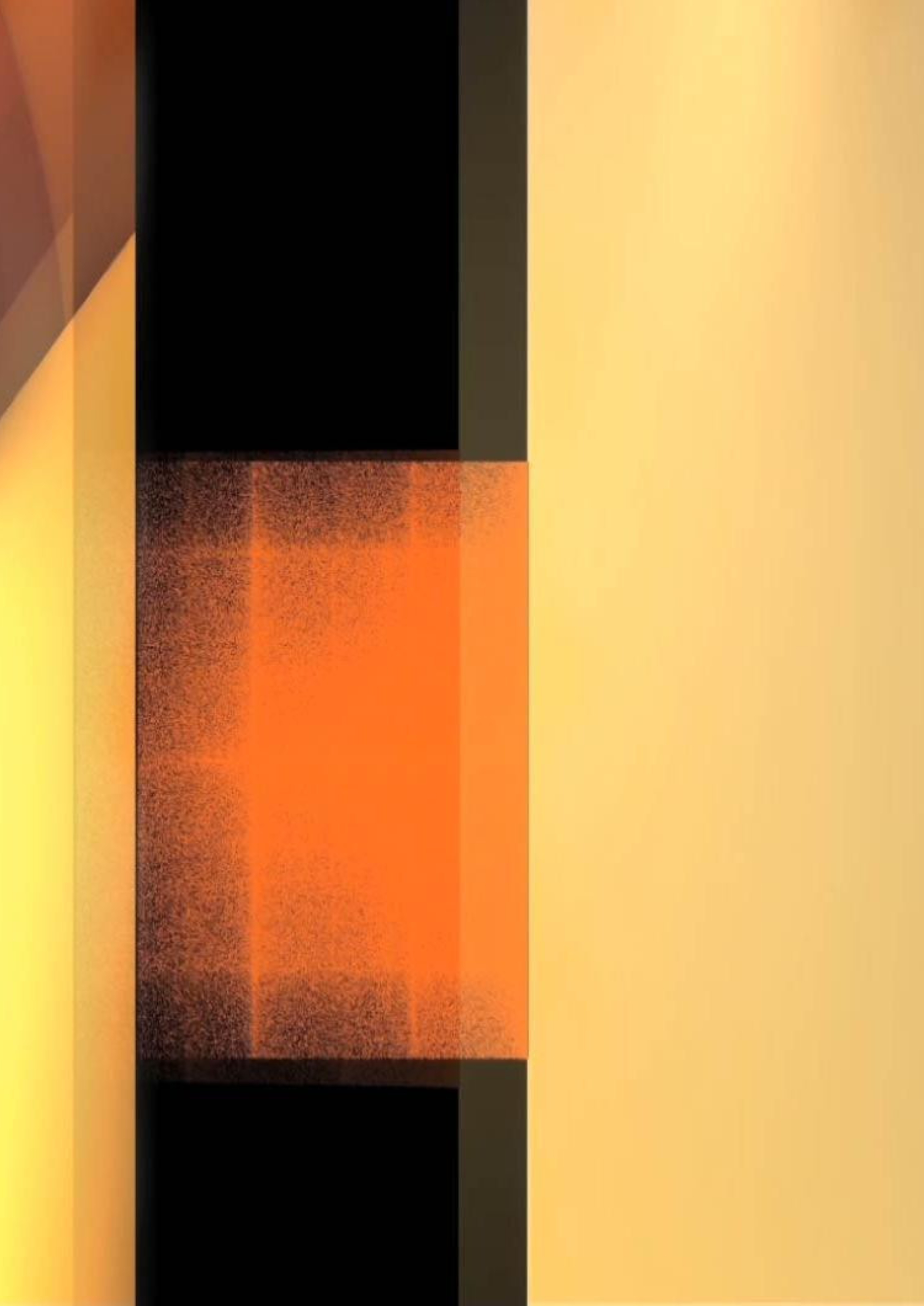
Anabela Costa
FILE São Paulo 2025 | LED Show
Festival Internacional de Linguagem Eletrônica
IN BETWEEN – França
O espaço entre, aquele que exploramos o tempo todo. O espaço entre é uma ponte. O poder do espaço entre!
BIO
Anabela Costa é artista visual, com diversas exposições individuais no seu percurso. A partir dos anos 80, passou a se interessar e a se direcionar progressivamente para a imagem digital. Desde 2000, desenvolve pesquisas no campo do cinema experimental, com foco em dois eixos: a imagem em movimento — a estética da representação do movimento — e a formalização de conceitos temáticos e científicos.
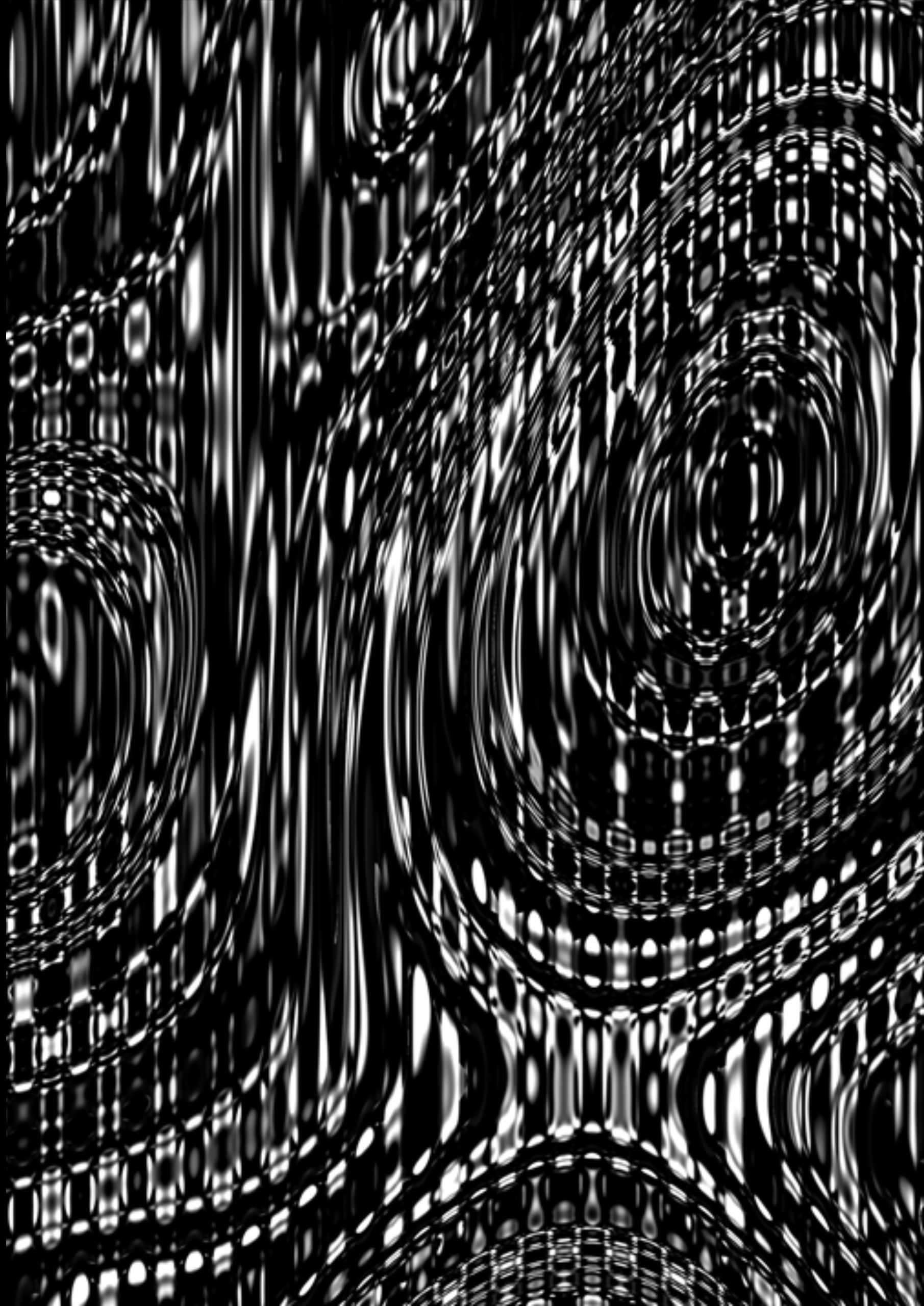
Arash Akbari
FILE São Paulo 2025 | LED Show
Festival Internacional de Linguagem Eletrônica
Gelîm – França
Gelîm é uma obra processual inspirada nos padrões repetitivos frequentemente encontrados em tapetes tradicionais, especialmente do Oriente Médio. A obra utiliza a função de ruído Simplex em 4D e fórmulas matemáticas para gerar padrões em constante evolução.
BIO
Arash Akbari é um artista transdisciplinar de Teerã, Irã. Sua pesquisa investiga a relação entre sistemas artísticos dinâmicos, percepção humana, narrativa não linear e a convergência entre os mundos físico e digital. Seu trabalho abrange os campos de sistemas generativos, design de interação, tecnologias imersivas e processamento em tempo real.
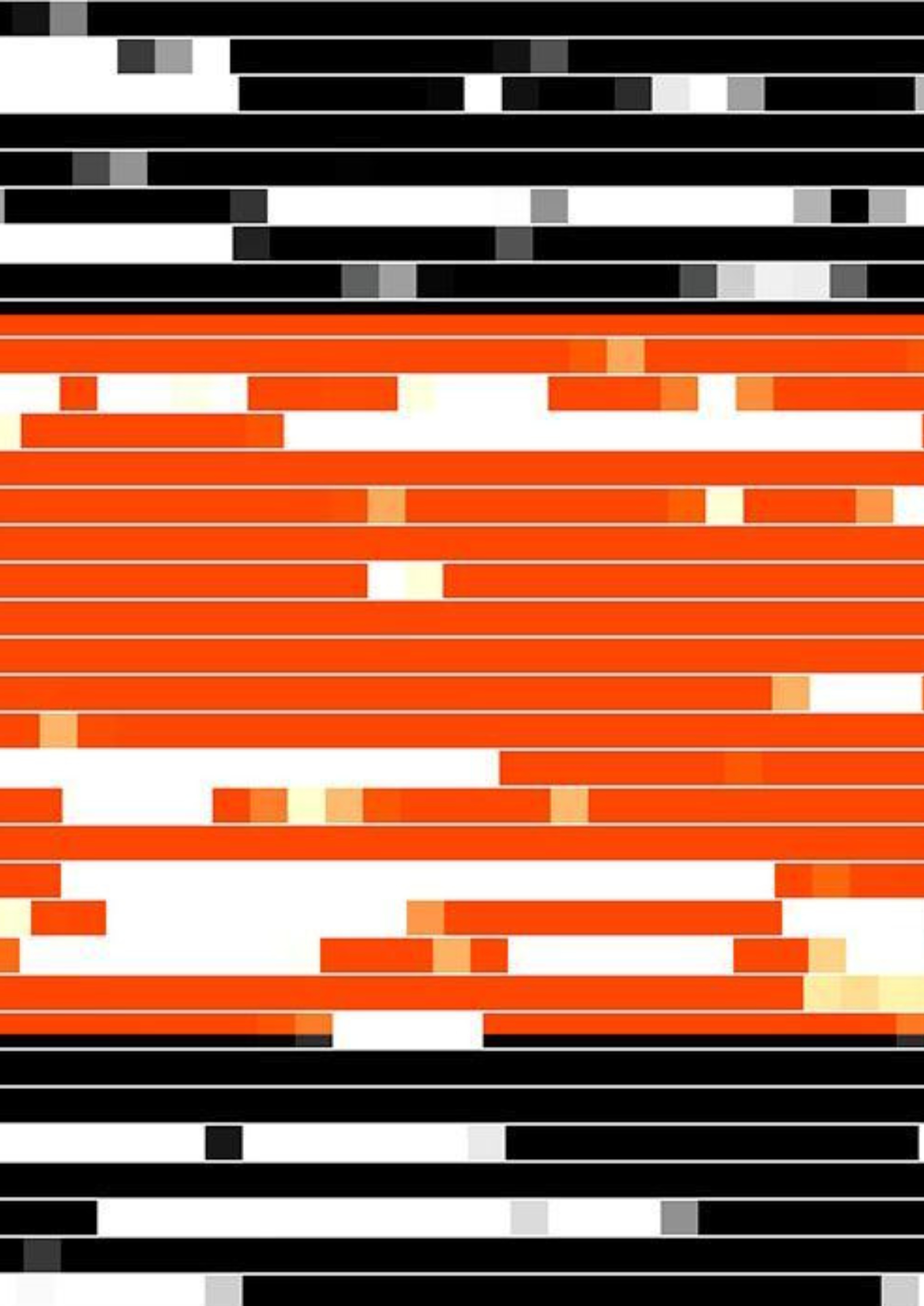
Hernan Roperto
FILE São Paulo 2025 | LED Show
Festival Internacional de Linguagem Eletrônica
RUÍDO/SINAL (Ruído Visual e o Fluxo Infinito de Dados) – Argentina
“Todo ambiente tem um ruído de fundo dominante. Tudo que se destaca visualmente será um sinal” — Jorrit Tornquist.
Convivemos com desinformações, bombardeio de informações e distrações constantes, criando um ambiente caótico e sobrecarregado. Este projeto interpreta metaforicamente o ruído visual como uma representação do fluxo infinito de dados em que estamos imersos, convidando à reflexão sobre como navegamos neste mar de dados e a sua influência em nossa percepção e compreensão do mundo.
BIO
Hernán Roperto é um VJ, artista audiovisual e engenheiro. Especializado em design visual para performances ao vivo, incluindo vídeo em tempo real, design de projeção, mapping e programação criativa. Seus projetos foram apresentados em vários festivais internacionais, como FILE (SP, Brasil), Live Performance Meeting (Roma, Itália), Mutek Argentina, Haptic Hybrid (NY), Biennale Esch.
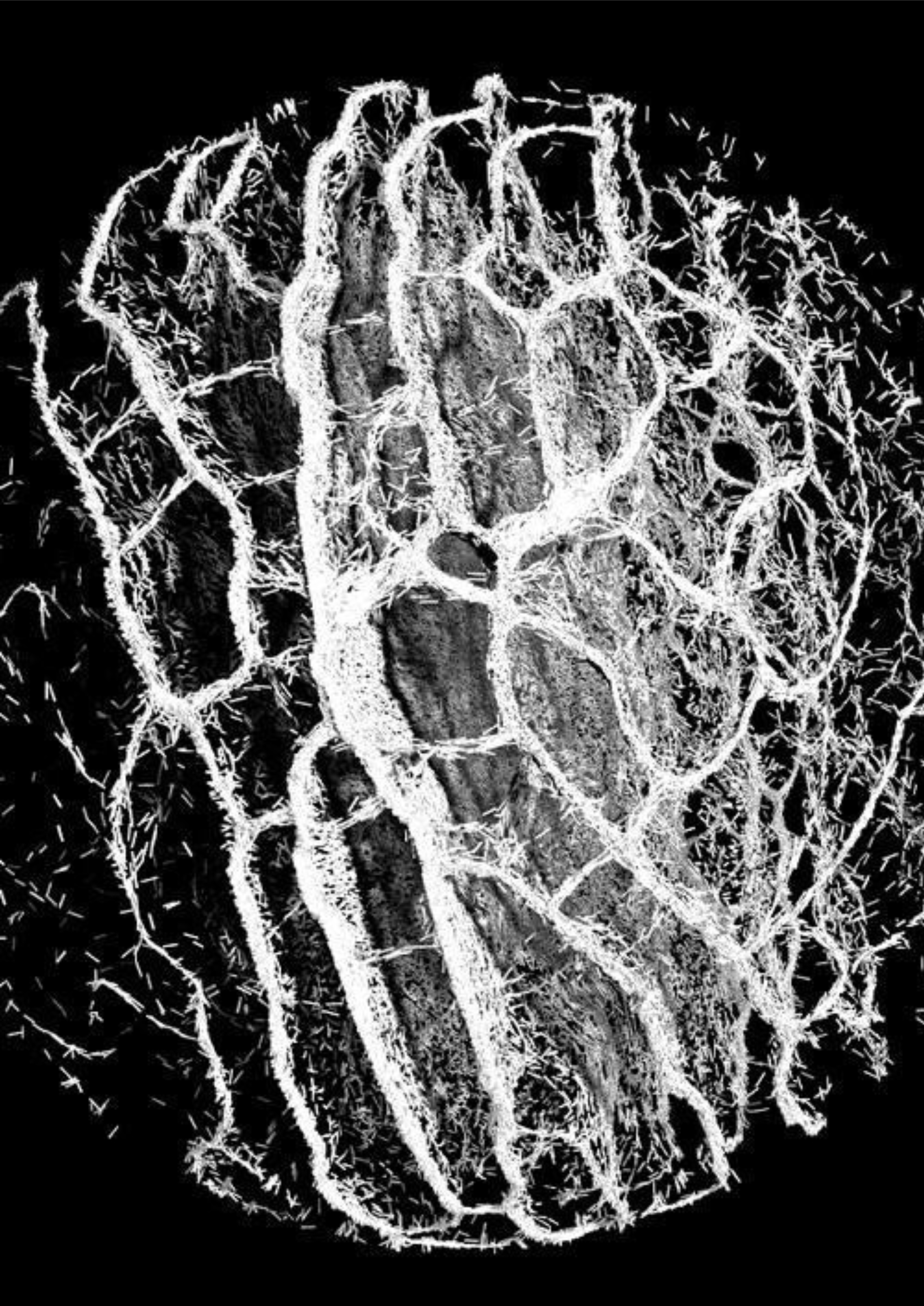
Ultravioletto
FILE São Paulo 2025 | LED Show
Festival Internacional de Linguagem Eletrônica
Mycelium — Natural Intelligence – Itália
A inteligência é frequentemente vista como aquilo que distingue os seres humanos, com a tecnologia como seu produto. Essa visão antropocêntrica exclui grande parte do mundo natural da ideia de progresso. E se a inteligência for um processo distribuído, resolvendo problemas por meio de conexões? Fungos otimizam redes de alimentação e comunicação pelo micélio, oferecendo um modelo para repensarmos nossa relação com a natureza e as cidades. Ultravioletto explora esse conceito em um vídeo gerado por algoritmos.
BIO
Ultravioletto é um estúdio criativo especializado em fundir arte e design com tecnologias interativas. Com uma abordagem não convencional, o estúdio integra novas mídias em projetos de pesquisa inovadores, contando com designers, programadores, artistas 3D e produtores.
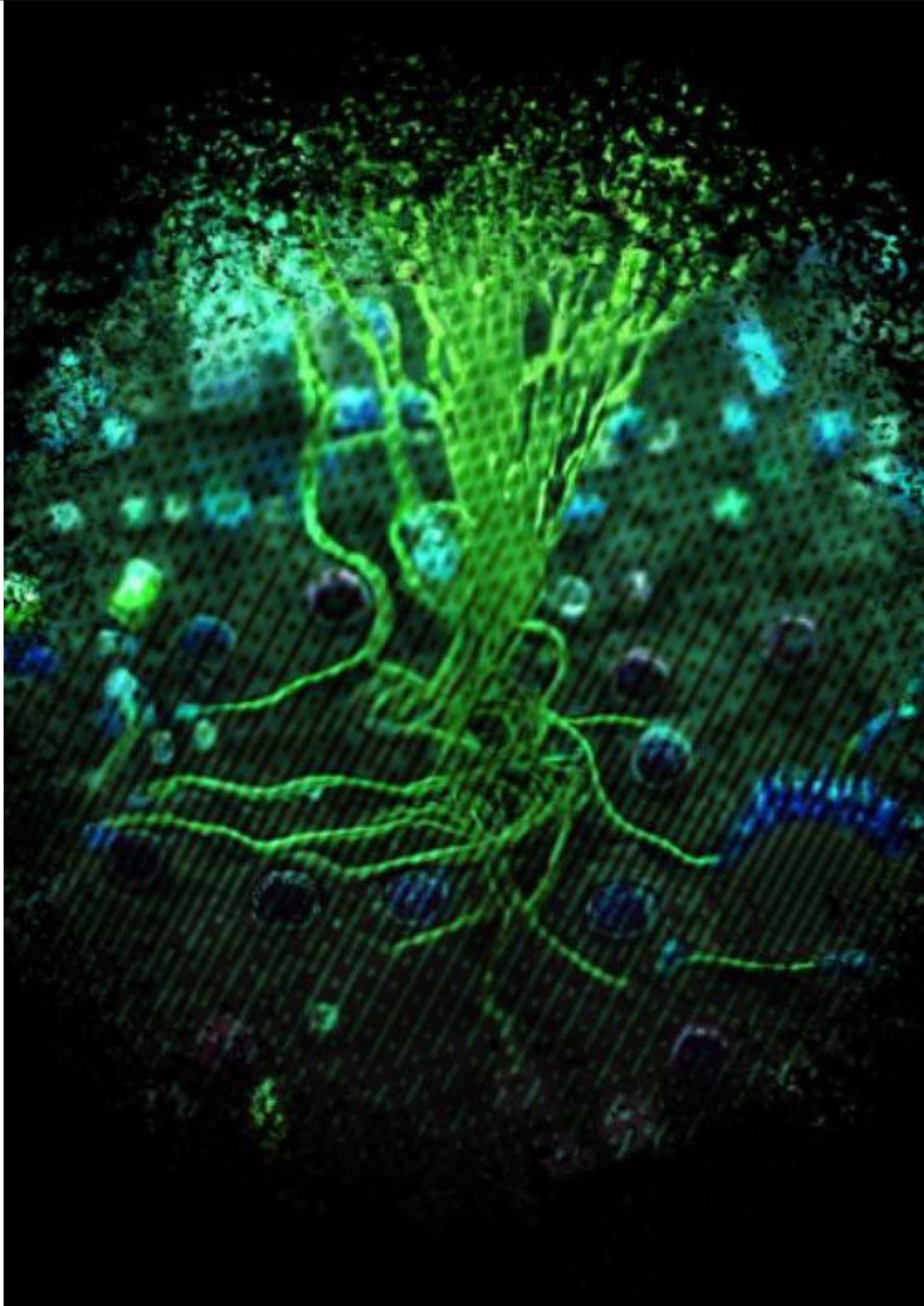
Silvia Ruzanka
FILE São Paulo 2025 | LED Show
Festival Internacional de Linguagem Eletrônica
Plant Growth Dreams – Estados Unidos
Plant-being (ser-planta) é um estado de crescimento perpétuo — de estender-se para baixo e para fora, atravessando fronteiras. A computação especulativa inspirada no pensamento vegetal envolve extensão e mistura, operando não por limites rígidos como os portões da lógica, mas por continuidades. A animação usa time-lapse e redes de difusão treinadas com plantas e eletrônicos, formando um sonho especulativo de híbridos vegetal-eletrônicos.
BIO
Silvia Ruzanka é artista e filósofa, atuando com animação, realidade virtual, instalações interativas e jogos experimentais. Seu trabalho foi exibido em festivais, galerias e museus internacionais. É professora assistente no Departamento de Artes e no programa de Artes de Jogos e Simulação do Rensselaer Polytechnic Institute, em Troy, Nova York.
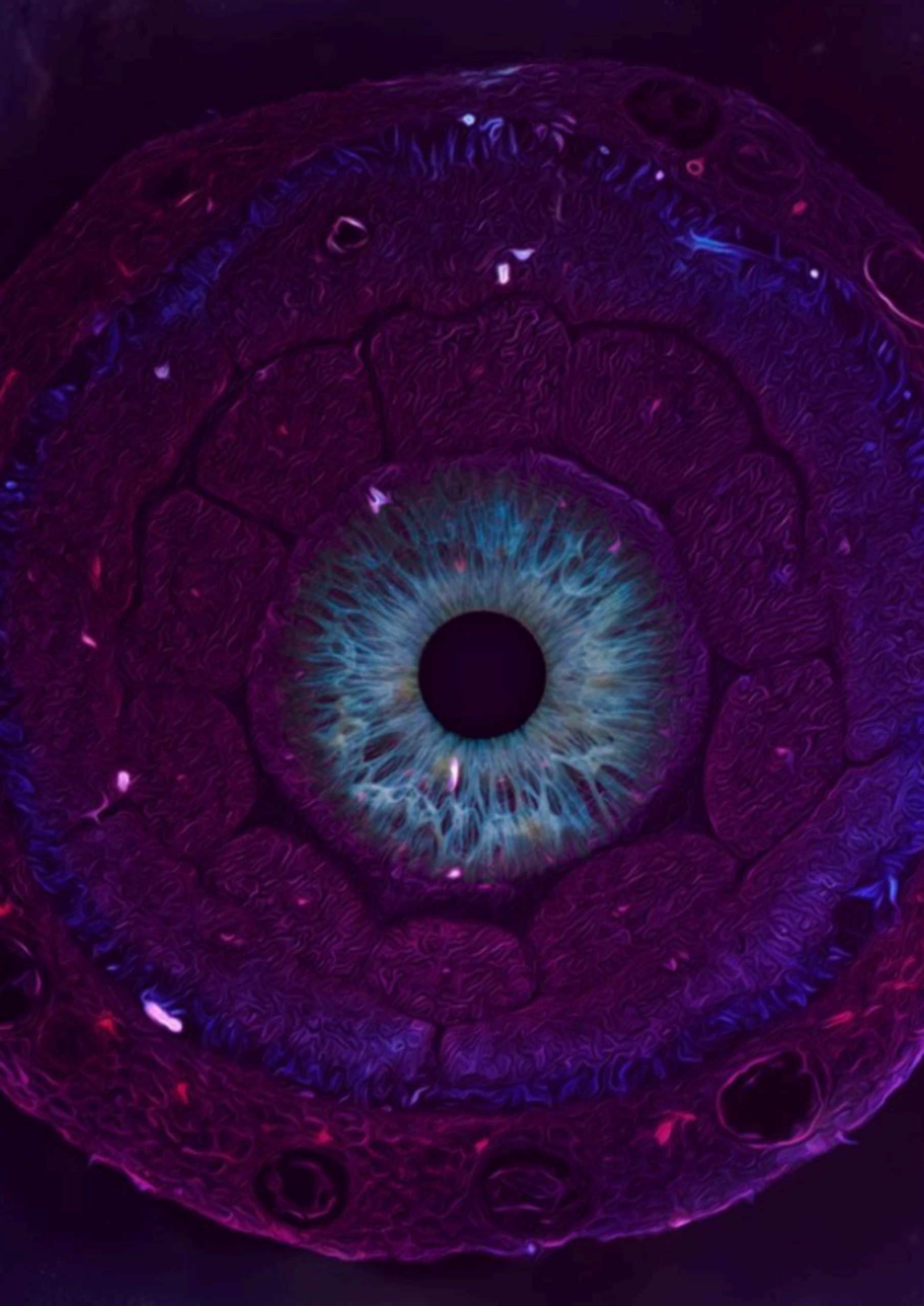
Parceria ECA-USP
FILE São Paulo 2025 | LED Show
Festival Internacional de Linguagem Eletrônica
Micrômacro – Brasil
Na categoria LED SHOW, a parceria entre o FILE e o Curso de Artes Visuais do Departamento de Artes Plásticas da Escola de Comunicações e Artes da Universidade de São Paulo resultou em trabalhos que foram desenvolvidos sob a orientação da Profa. Dra. Silvia Laurentiz, e com a colaboração de Dimitri Lomonaco. Esta parceria busca reafirmar a conexão entre o Festival e a Universidade, estimulando a produção de arte em novas mídias: uma oportunidade ímpar de acesso a linguagens, tecnologias de ponta e recursos inovadores para reflexão e experimentação no ambiente artístico e entre circuitos culturais. Micrômacro é um compilado de vídeos, independentes entre si, que foi desenvolvido a partir da seguinte sinopse:
O que distingue o todo da parte? Onde é o limite do “nós” para o “eu”? Em que momento me separo? Este trabalho é um com-junto de investigações sobre o comprimento indivisível da cisão, a fronteira entre o que o separa e o que une. Micrômacro é o resultado dessa divisão. Unidade significante do contraste. Parte/Todo do mundo. Presente em cada parte, por toda parte, crono-micro-macrando entre nós.
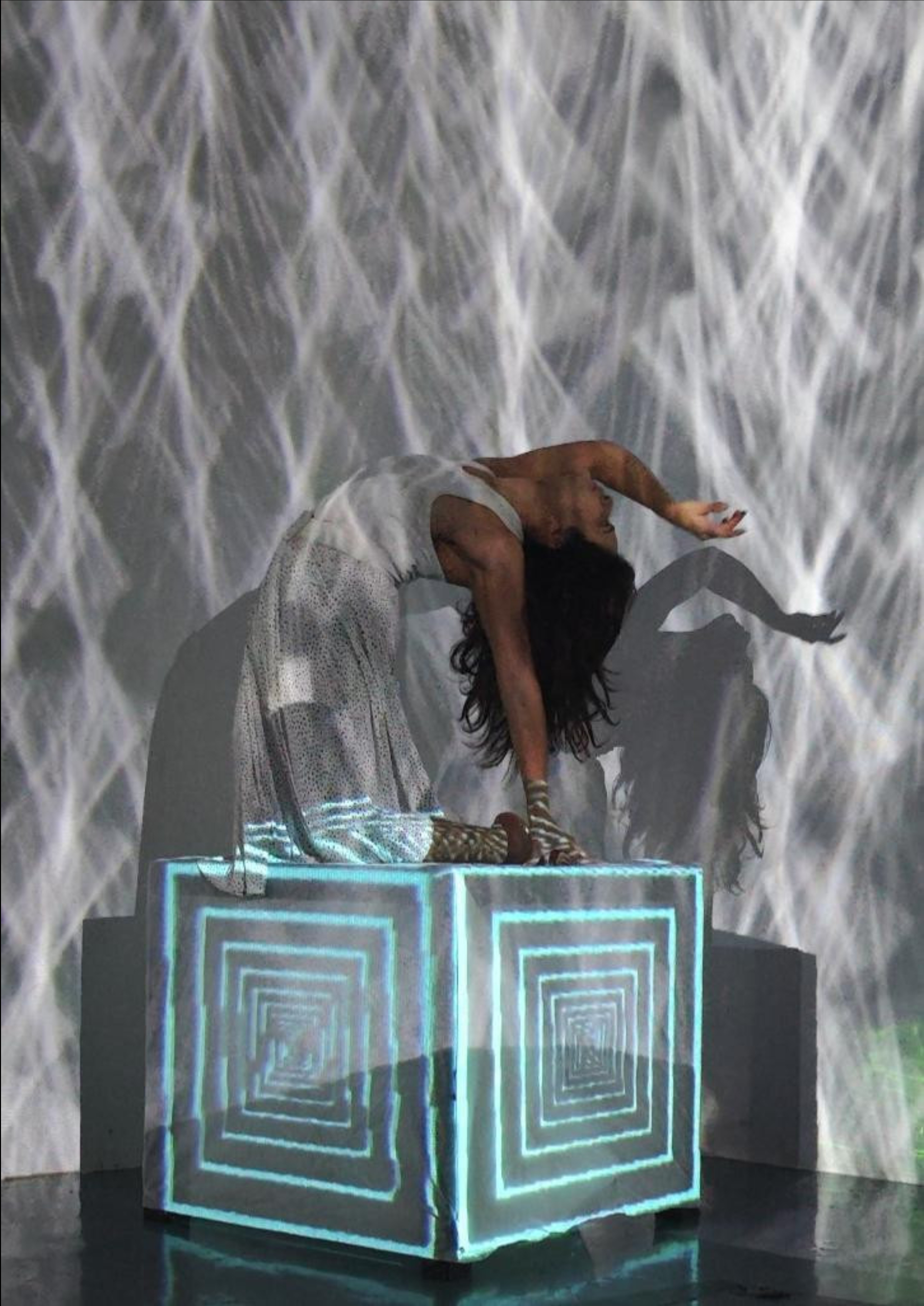
WOW Studio by D2D
FILE São Paulo 2025 | LED Show
Festival Internacional de Linguagem Eletrônica
UnBoxing the Infinite – Egito
A obra explora a interseção entre realidade e hiper-realidade. Enquanto uma dançarina atravessa espaços de confinamento, descobre portais e cria mundos mágicos com o público. Usando rastreamento de movimento dinâmico e visuais ao vivo, a performance inspira transformação, criatividade e autolibertação, rompendo fronteiras da percepção.
BIO
Elena Kauffmann é fundadora e diretora criativa do WOW Studio (Egito), voltado para artes midiáticas, XR e IA. Idealizou a WOW Zone, um espaço experimental impulsionado por tecnologias imersivas, e é cofundadora da desenvolvedora de VR UBR. Atua como produtora criativa, designer de experiências imersivas e diretora de arte. Carolina Assis é bailarina contemporânea colombiana radicada no Egito. Amr Ali é um dos principais artistas de tecnologia do WOW Studio.
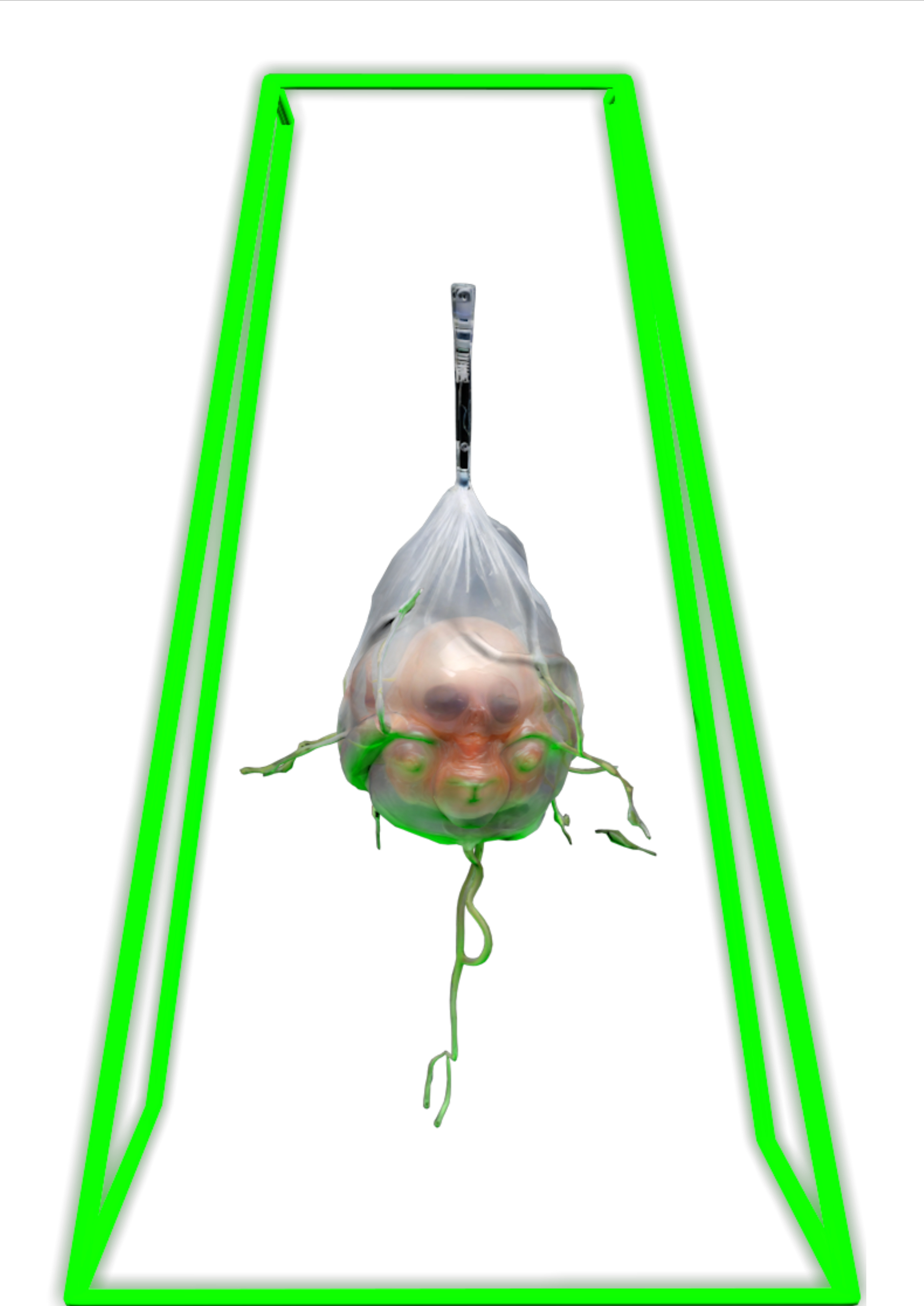
Fredo Agudelo
FILE São Paulo 2025 | LED Show
Festival Internacional de Linguagem Eletrônica
mutanttales — Postterra – Colômbia
No final, o orgânico comerá o lixo tecnológico como os fungos. O que sobra de humanidade neste final? O que fica da Terra sobre a vaidade humana? Somos seres em uma mistura inconsciente, sentados atrás de telas como que viajando em uma nave no vazio do universo. As camadas caem e fica nossa realidade corpórea. Escaneie sua consciência e saia da sua nave, em Postterra ainda tem mundo para viver.
BIO
Artista audiovisual colombiano residente em São Paulo. Tem experiência com videomapping trabalhando na Colômbia em diversos projetos e participando em vários festivais de videomapping no Brasil. No momento se encontra trabalhando cada vez mais com o som para trazer uma mostra audiovisual ao vivo ao circuito da arte audiovisual, misturando som experimental com videoprojeções.
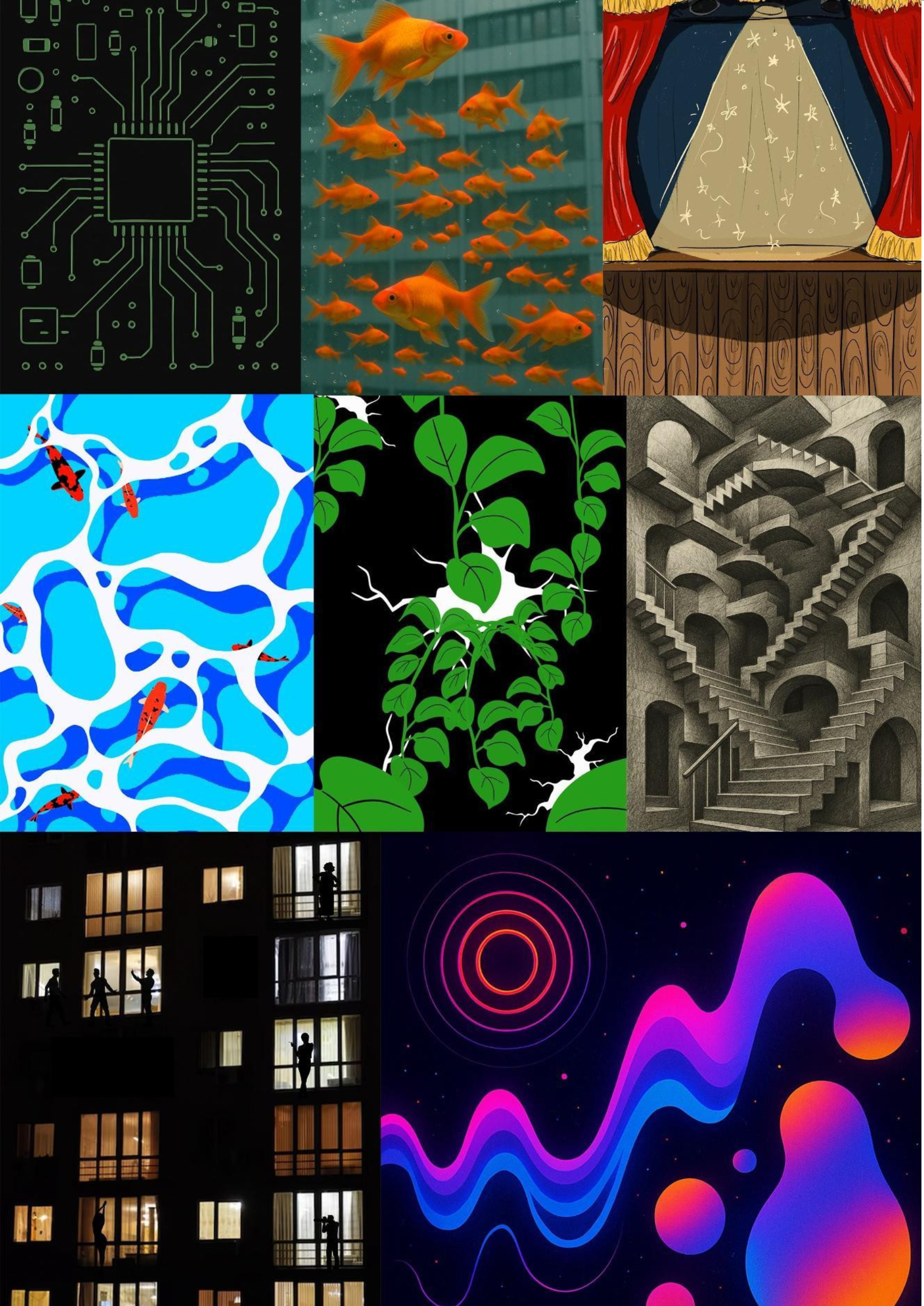
Parceria IED
FILE São Paulo 2025 | LED Show
Festival Internacional de Linguagem Eletrônica
Superfícies – Brasil
Vigas de concreto, vidro, paredes de tijolos, cimento… Prédios são feitos para durar, para resistir ao tempo. Já as telas de LED vivem da luz que emitem — acendem, se misturam, apagam. São efêmeras. Quando um edifício se reveste de LEDs, surge o encontro entre o permanente e o transitório, entre o que já é e o que pode vir a ser. No icônico prédio da FIESP, na Avenida Paulista, o design de superfície transforma a arquitetura em um campo de experimentação. Ali, estudantes do IED SP exploram novas possibilidades de existência desta edificação, ressignificando a estrutura por meio da luz animada e do design.
BIO
As alunas e os alunos do bacharelado em Design Gráfico e Digital do Istituto Europeo Di Design (IED SP) se uniram para a criação de uma obra coletiva de animações inspiradas no design de superfície, na sua ressignificação e materialização midiática em busca de explorações de linguagem para projetos de comunicação visual. O IED é uma rede internacional de formação e pesquisa em Design, Moda, Comunicação Visual e Gestão de disciplinas criativas.
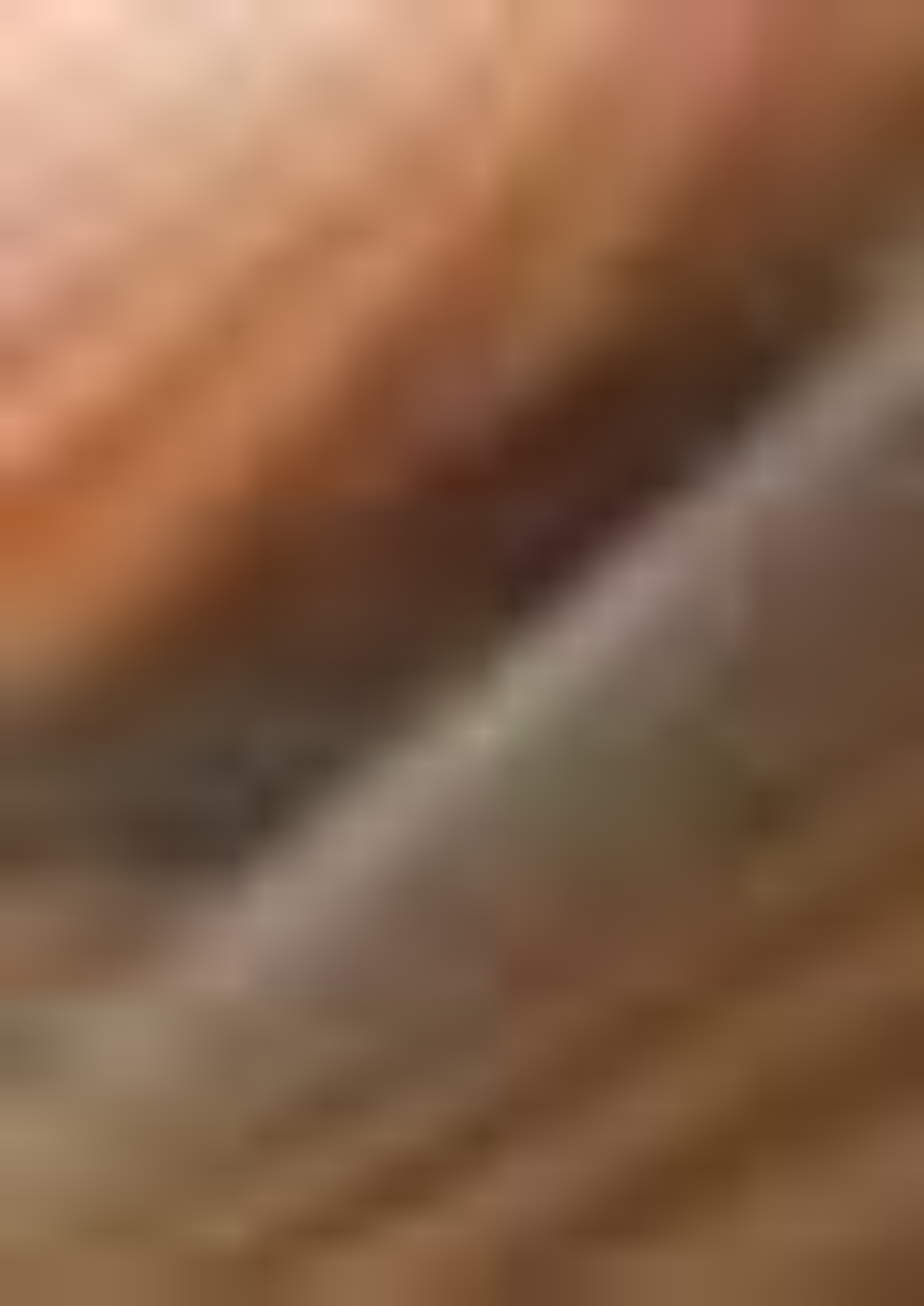
Anabela Costa
FILE São Paulo 2025 | LED Show
Festival Internacional de Linguagem Eletrônica
sliding stripes – França
Deslizando o olhar sobre uma tela lisa e brilhante.
BIO
Anabela Costa é artista visual, com diversas exposições individuais no seu percurso. A partir dos anos 80, passou a se interessar e a se direcionar progressivamente para a imagem digital. Desde 2000, desenvolve pesquisas no campo do cinema experimental, com foco em dois eixos: a imagem em movimento — a estética da representação do movimento — e a formalização de conceitos temáticos e científicos.

QUBIT AI | quantum & synthetic ai
Electronic Language International Festival
July 3rd to August 25th
Tuesday to Sunday, 10am – 8pm
FIESP Cultural Center
Design: André Lenz
Image: Iskarioto Dystopian AI Films – Athena
QUBIT AI
In its 25 years of existence, the International Electronic Language Festival (FILE) is an internationally renowned Brazilian project that since 2000 has explored the intersection between art and technology. With more than two decades of history, the festival stands out for fostering exhibition spaces and debate about artistic innovations driven by disruptive and innovative technologies, inviting the public to get involved with experimental forms of art that challenge the boundaries of conventionality. Currently, two of these technologies stand out in the contemporary scenario: the accelerated development of quantum computing and artificial intelligence corroborated by synthetic data.
Quantum computing, an emerging revolution in the technological field, offers a new range of creative possibilities for contemporary artists. This new era allows the exploration of unprecedented frontiers through a new computational format that consists mainly of quantum superposition and entanglement, a new field of exploration for synthetic computer science, as well as for the arts in general; on the other hand, artificial intelligence, fueled by synthetic data, offers artists a new way of making and understanding art, opening up space for new forms, concepts and artistic expressions.
Entitled QUBIT AI, the exhibition delves into this unexplored territory presenting a selection of works of art resulting from the connection between artistic creation and technology, proposing a theoretical reflection on what the interrelationship between quantum computers and synthetic artificial intelligence will be.
Visitors will be invited to experience immersive installations, experimental videos, digital sculptures and other forms of interactive art, which intertwine reality and imagination. The exhibition encourages reflections on the influence of technology on art and contemporary society, while at the same time providing an environment to compare already established technological arts (analog and digital) with the possible futures of art in the synthetic era, enhanced by quantum computing. The QUBIT AI exhibition at FILE SP 2024 transcends the mere presentation of works of art; it is a journey to the limits of human creativity, driven by the convergence of art, science and technology.
Ricardo Barreto and Paula Perissinotto
co-organizers and curators of FILE
International Electronic Language Festival

Bots
FILE 2024 | Installations
International Electronic Language Festival
Bots presents a computer-controlled society through a series of algorithmically controlled humanoid avatars that appear on physical carpets using augmented reality (AR). Real-time performances synthesize human behavioral patterns into a formalized digital social study. Omnipresent, combined with our devices and incorporated into virtual environments, the work reminds us of our own digitalized world, in which we are surrounded by invisible bots.
Bio
Giulia Bowinkel (born 1983) and Friedemann Banz (born 1980) live in Berlin and have worked together under the name Banz & Bowinkel since 2009. In 2007 they graduated from the Art Academy with Albert Oehlen and started making art with computers . His work encompasses computer-generated imagery, animation, augmented reality, virtual realities and installations.
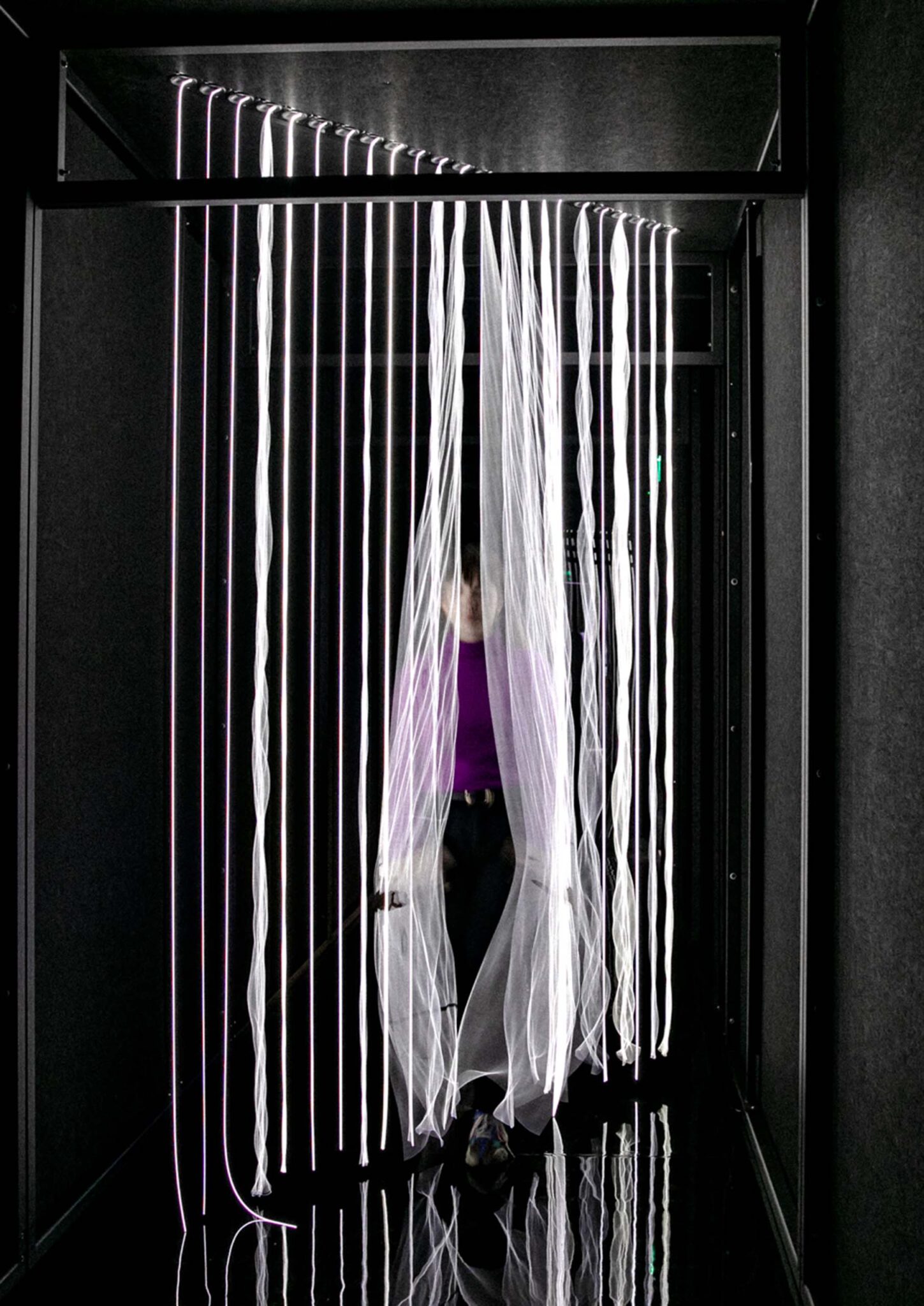
Shell of
FILE 2024 | Installations
International Electronic Language Festival
Marc Vilanova – Cascade – Spain
Waterfalls are a continuous source of infrasonic frequency found in nature. Although inaudible to humans, they play a crucial role in ecosystems, especially for migratory birds who use them as a compass. However, many waterfalls have lost their frequencies due to climate change. The work creates an immersive experience in which the audience interacts with the visualization of sound waves, experiencing the vibration of sound through illuminated strings.
Bio
Marc Vilanova is a sound and visual artist who works at the intersection of art, science and nature. Vilanova’s artistic production has always been led by a spirit of innovation fueled by an interest in new media. His practice combines sound/light installations, performance, and sculpture.
Credits
This work was partially carried out within the scope of the EMAP program at gnration, with the support of the Creative Europe Culture Programme, the Avatar Center in Quebec City and the Ramon Llull Institute.
Photo:
Eloise Coomber

EGO
FILE 2024 | Installations
International Electronic Language Festival
The mirror stage in psychology explains how the Ego forms through objectification, where one’s visual appearance comes into conflict with emotional experience, a concept called ‘alienation‘ by psychoanalyst Jacques Lacan. The interactive installation EGO reenacts and reverses this process by distorting the mirror image based on the user’s movements, highlighting the tension between the real and the symbolic, the Ego and the It, subject and object.
Bio
Klaus Obermaier is an interdisciplinary artist, director and composer who creates innovative works in the performing arts, music and installations using new media. Stefano D’Alessio researches social issues induced by the internet and explores how the web and its derivatives influence human behavior and the body. Martina Menegon creates intricate assemblages of physical and virtual elements, exploring the contemporary self and its hybrid corporeality.
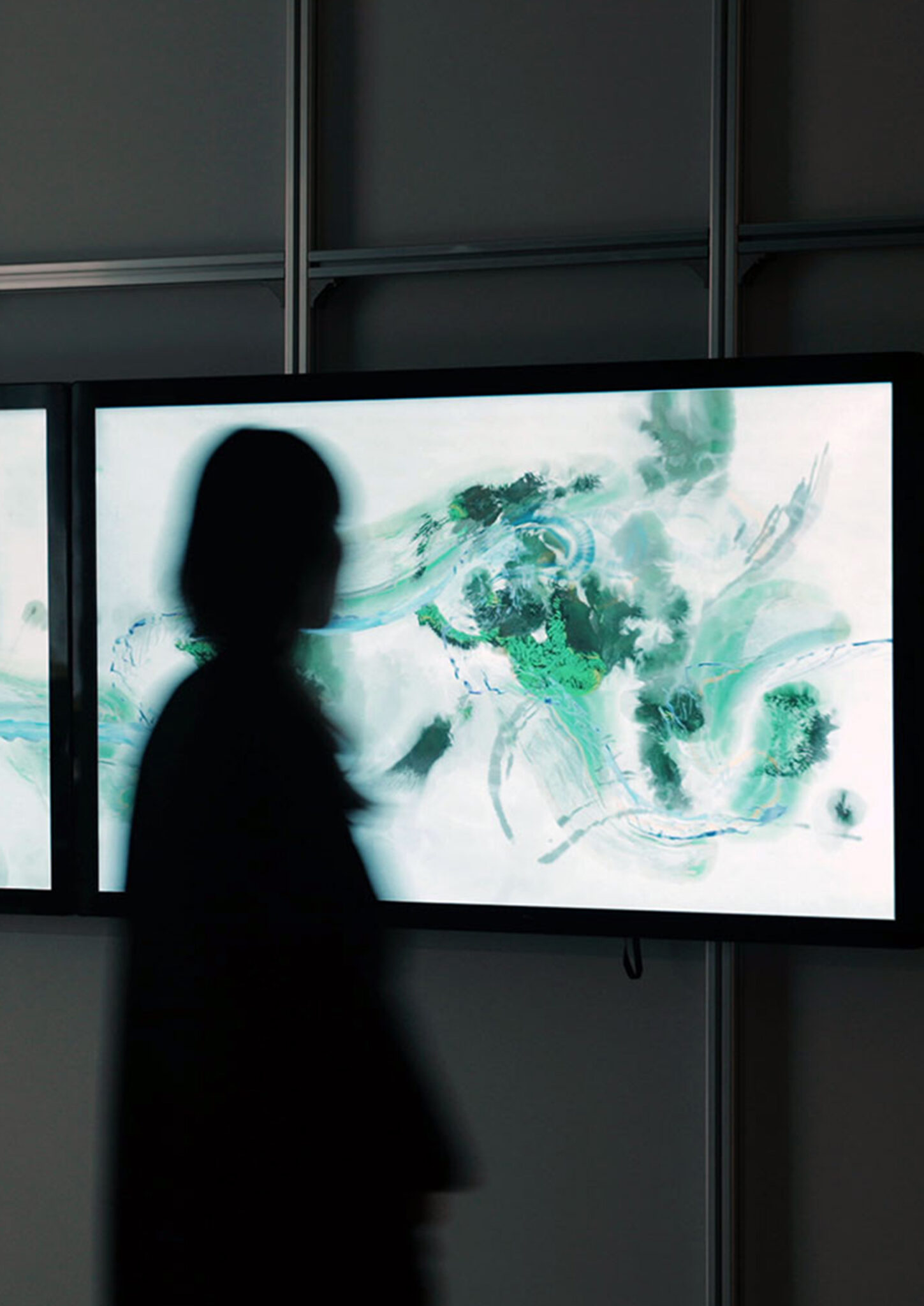
Everything Before, Everything After
FILE 2024 | Installations
International Electronic Language Festival
Seph Li – Everything Before, Everything After – China and UK
A digital installation features a winding river in the style of Chinese painting, symbolizing time and transition. Touch screens allow visitors to paint over it, altering its course unpredictably. The river embodies history and the future, with each trace contributing to its eternal flow through space and time. Recorded interactions ensure its perpetual existence.
Bio
Born in Beijing in 1988, Seph Li has a mixed background in technology and design, and his keen interest in interactive artworks led him to the field of media arts. Seph studied computer science and entertainment design at Tsinghua University and continued his master’s study in design/media arts at UCLA. Seph currently resides in London, United Kingdom; he creates interactive artworks as well as technical experiments with other production studios.

Useless Hands
FILE 2024 | Aesthetic Synthetics
International Electronic Language Festival
Infratonal – Useless Hands – France
When our hands become useless, what will we choose to do with them? We can use AI to visualize the unthinkable, the strangely familiar yet indescribable forms and structures. Generative AI could be used as an amplifier of our ability to explore abstraction and surrealism rather than a simple mirror of our usual perceptions.
Bio
Infratonal is an artistic project led by Louk Amidou, a Paris-based multidisciplinary artist who works at the intersection of digital arts, electronic music and interaction design. He uses algorithms to create hybrid visual and sound pieces which aim to be performed by the human gesture as intangible instruments. He questions the artwork’s nature at the age of AI and the relationship between the artist and the algorithm.
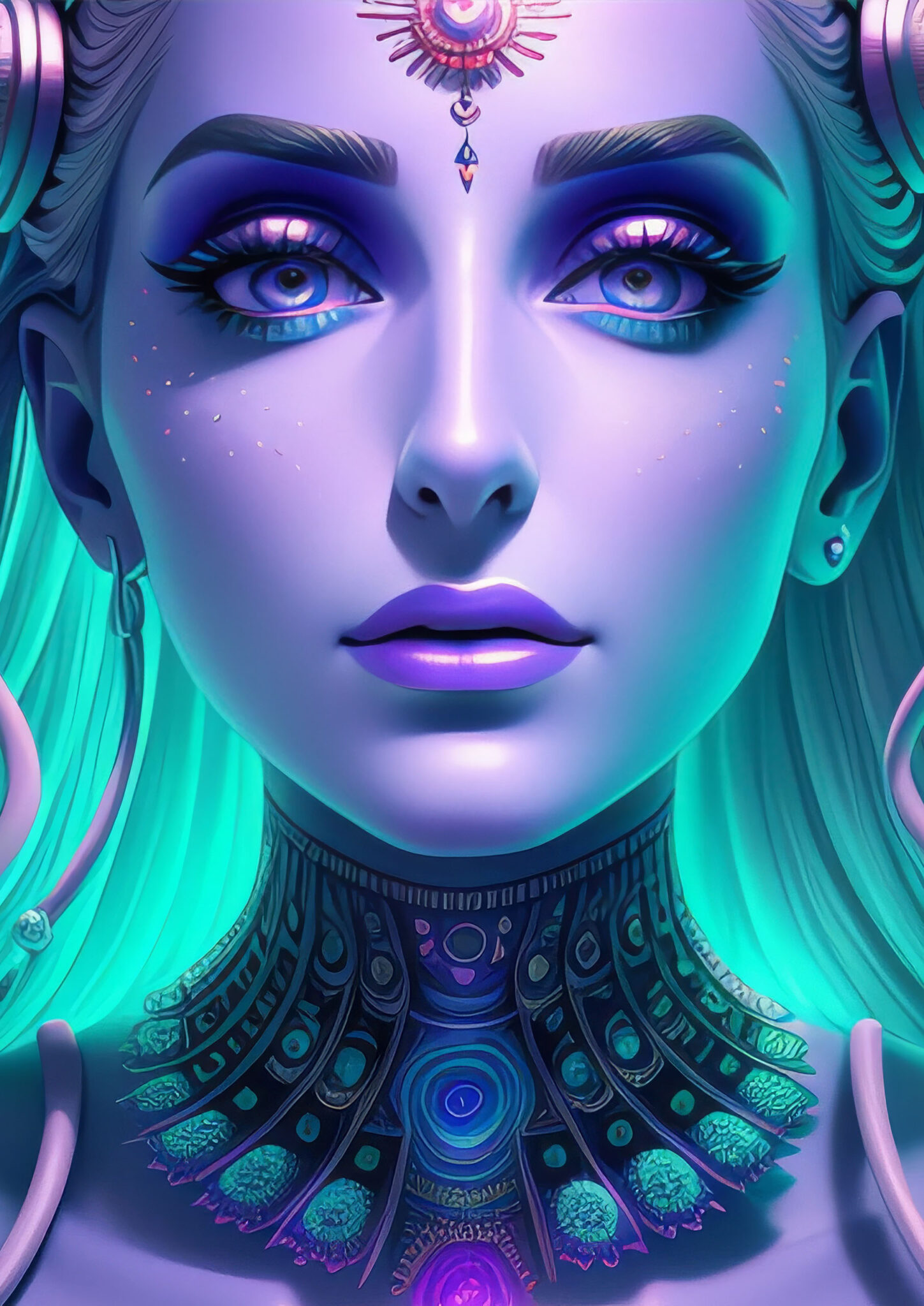
Squid
FILE 2024 | Interator – Sound Synthetics
International Electronic Language Festival
Verbo Pluriel (aka volt46) & XWave – Calamar – United States and France
The Calamar music video is comprised of AI-generated clips that are sequenced and synchronized to create a hypnotic, ever-changing landscape.
Bio
Verbo Pluriel is an electronic music producer who has been active in the NFT scene since 2020 under the name volt46. X-Wave is also an NFT producer that trains its own AI models to generate collections. Although they never met in person, their participation in the web 3.0 art collective Based Ghouls led to their collaboration.
Credits
Music: Calamar (Kraken Mix) by Verbo Pluriel
Music Video: volt46
AI Video Generation: XWave

Blob Alien Mouth
FILE 2024 | Interator – Sound Synthetics
International Electronic Language Festival
Luigi Novellino (aka PintoCreation) – Blob Alien Mouth – Italy
The journey begins with Deforum, using the Automatic1111 interface to create basic images with the StableDiffusion XL, EndjourneyXL, and Lora XLFullArt templates. The video undergoes a transformation using the Absolute Reality model and Lora Aurora style, guided by the IPAdapter node and refined by QrCode Controlnet.
Bio
Fascinated by the limitless domain of AI, Luigi Novellino adopts the title syntographer, a term that resonates deeply within the community. The artist often asks himself: “am I an artist?” Art, in his view, defies rigid definitions or limits; it represents a fluid expression of creativity that transcends labels. The artist’s ultimate goal is to awaken something in the viewer, provoking thoughts and evoking emotions.
Credits
Music: Oleh Boretskyi
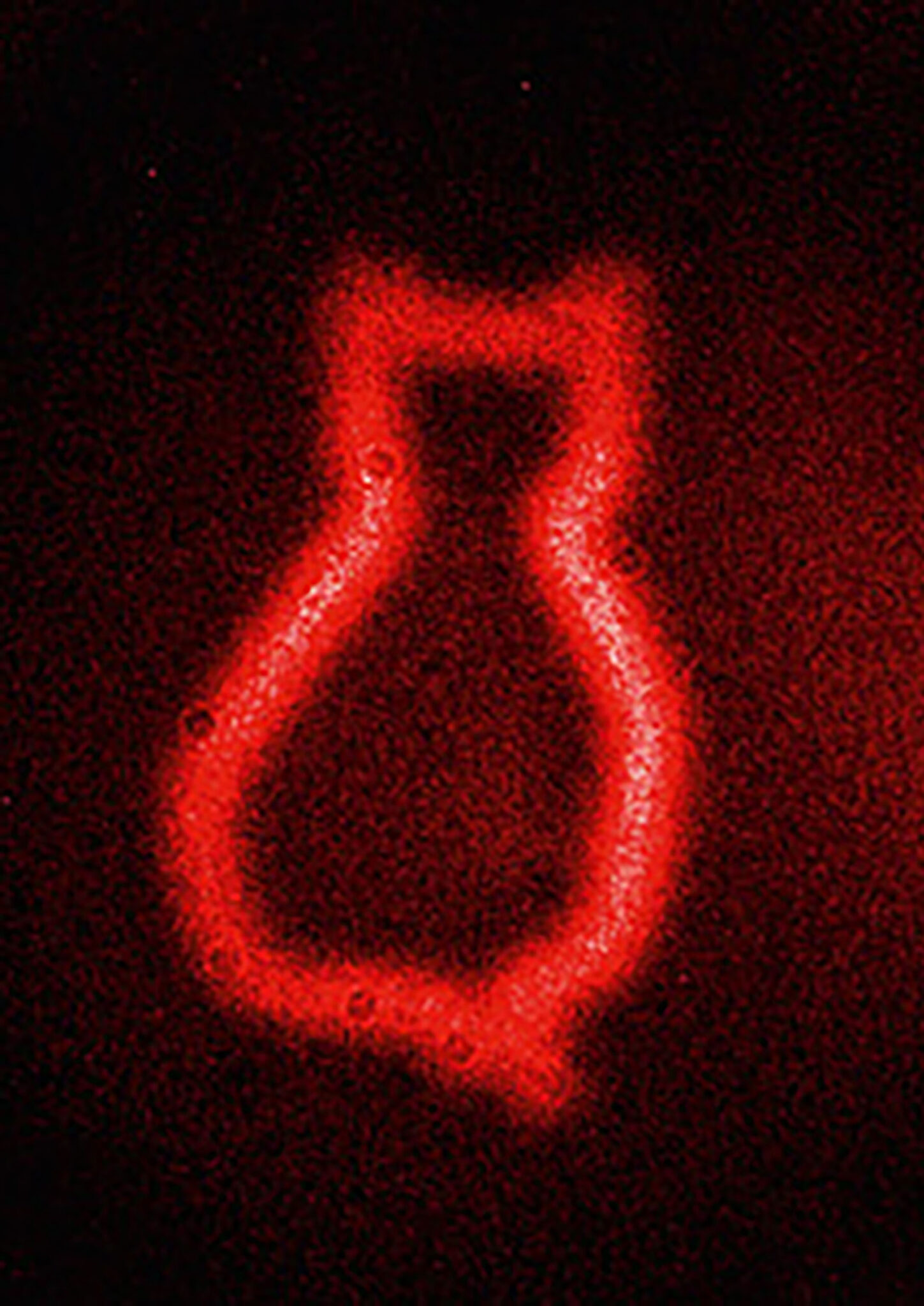
Quantum Photography
FILE 2024 | Quantico
International Electronic Language Festival
Gabriela Barreto Lemos – Quantum Photography – Brazil
Quantum photography technique that allows you to record images without light passing through the object.
Typically, a beam of light interacts with an object; In this same beam, the image of that object is formed, which is recorded on a camera, on paper or directly into the eye. This research used two quantumly entangled photon beams. An infrared photon was directed at a silicon wafer engraved with the image of a cat. The other photon, red, was sent on a different trajectory, did not pass through the silicon plate and was detected by an EMCCD (electron-multiplying charge-coupled device – a photographic camera with sensitivity to very low intensity light). The image of the cat engraving was recorded by the camera, which only detected the red light, which did not touch the engraving. It is the first time that an image has been captured in a beam of light that has not interacted with the object that produced the image.
The experiment, led by researcher Gabriela Barreto Lemos, was carried out at the Institut für Quantenoptik und Quanteninformation in Vienna, 2014.
The technique has potential for applications in indirect image capture, from medicine to quantum computing.
Bio
Professor at the Federal University of Rio de Janeiro, in Brazil, whose research focus is on quantum optics, with an emphasis on quantum foundations, quantum images and quantum information. Additionally, she is involved in interdisciplinary creative projects and promoting inclusion and diversity in science.
Credits
Gabriela Barreto Lemos
Vienna Center for Quantum Science and Technology
Institut für Quantenoptik und Quanteninformation
Group of Anton Zeilinger

“DIFFERENT DIMENSION”
“Various winds are accumulated, pulled out, fluttered, rotated … Repeated over and over again. The invisible wind has the same expression for one second. Isn’t it possible to “see” with a dress that can’t be seen? It is a challenge to design your own style through dress making. ” yoshio kubo

ADAD
This installation is a mechanism that serves as a kind of interface between planetary processes and an audience. It consists of 12 transparent piezocrystals, grown especially for the project, and 12 motorized hammers that strike them. The installation is connected to the internet. Its core algorithm is controlled by data from a meteorological site which shows lightning strikes in real time (on average, 10~200 lightning flashes occur on the planet every minute). Each time the installation receives information about a lightning strike, a hammer strikes one of the crystals, resulting in a small electrical discharge produced by the crystal under mechanical stress. Each of these charges activates a powerful lamp and sound effects.

Keigo Matsumoto, Yohei Yanase, Takuji Narumi & Yuki Ban
FILE FESTIVAL 2018
“Unlimited Corridor ” é um sistema de VR que permite a experiência de percorrer um vasto mundo virtual num espaço físico estreito, manipulando a percepção espacial. Esta obra utiliza uma técnica chamada andar visual-háptico redirecionado que utiliza a incerteza da percepção espacial humana e a interação entre visão e senso háptico.
.
“Unlimited Corridor” is a VR system that allows the experience of traversing the space of a vast narrow physical virtual world, manipulating spatial perception. This work uses a technique called redirected visual-haptic spatial walking that utilizes the uncertainty of human perception and the interaction between vision and haptic sense.

FILE SAO PAULO 2017
THE BREATHING CLOUD
“The Breathing Cloud” is a monumental floating organism. The work transforms a space by its motion, light, and rhythmic breathing. With this light art the phrase “let a room come to life” gets a new meaning. The clouds skin looks fragile and soft, and the movements are rhythmic, yet random, so the whole room feels like a living being. The technology is designed so that the strong LED modules and the mechanism support the pervasive breathing. It gets physically bigger and smaller and embraces with its bright light space.

CEREMONIAL FORMALITY
Frederik Heyman’s work is a balancing act incorporating multiple media – including video, installations and photogaphy – often in a digitally altered environment. In his work, Heyman explores memory and duration, using photogrammetry and 3D scanning to depict and represent the passage of time. The hallmarks of Heyman’s work are mechanical and technological: wires, wheels, scrolling LED marquees, metal frames, clamps, industrial lights, screens and cameras. Bodies–as opposed to humans–are subject to unusual dynamics with these technological trappings. In Ceremonial Formality (2020) a contortionist is encased in a metal cage while a spectator, hooked up to wires, looks on.

DIMENSION
Mamoru Hosoda collaborated with Morinaga to create this great collection film. It begins with the formation of the clothes as Morinaga designed them, not through cut and drape but via cut and paste, and we see the garments as digital toiles made up of fractal contours true to the representation of futuristic facades stretching back to Metropolis and Tron. Then the dresses form more tangibly, but still in 2D, filling those vectored spaces with the angled jigsaw of reclaimed denim, chino cotton, and gabardine, plus reflective material (all seamlessly bonded) from which they are made. It slowly becomes kind of clear that we are seeing a fashion show in U, the virtual world which Belle’s heroine inhabits—and that it is also being streamed on U’s equivalent of YouTube. There are rooms within rooms within rooms.
.
仮想世界は二次元。非日常の世界。現実世界は三次元。日常の世界。仮想とは、現実にはない世界を仮にあるものとして考えてみること。現実とは、事実として目の前にあらわれている世界そのもの。2022年春夏コレクション「DIMENSION」は二次元と三次元を越境する。画面の中の世界は二次元。細田守監督最新作「竜とそばかすの姫」のアニメーションの世界。劇中に存在する仮想空間’’U’’でコレクションが幕を開ける。CGアバターモデルが、宙に浮くガラスのランウェイを歩く。画面の外の世界は現実。‘’U’’が投影された真っ白な空間を、実在のモデルが歩く。コロナ禍がもたらしたデジタルのファッションショーは、軽々と世界の距離を縮め、すべてをフラットにした。画面の中では、立体と平面の区別はなくフラット。画面の中と外の境界もまた、消えていく。画面の外で纏うだけでなく、画面の中でも纏うことができる。
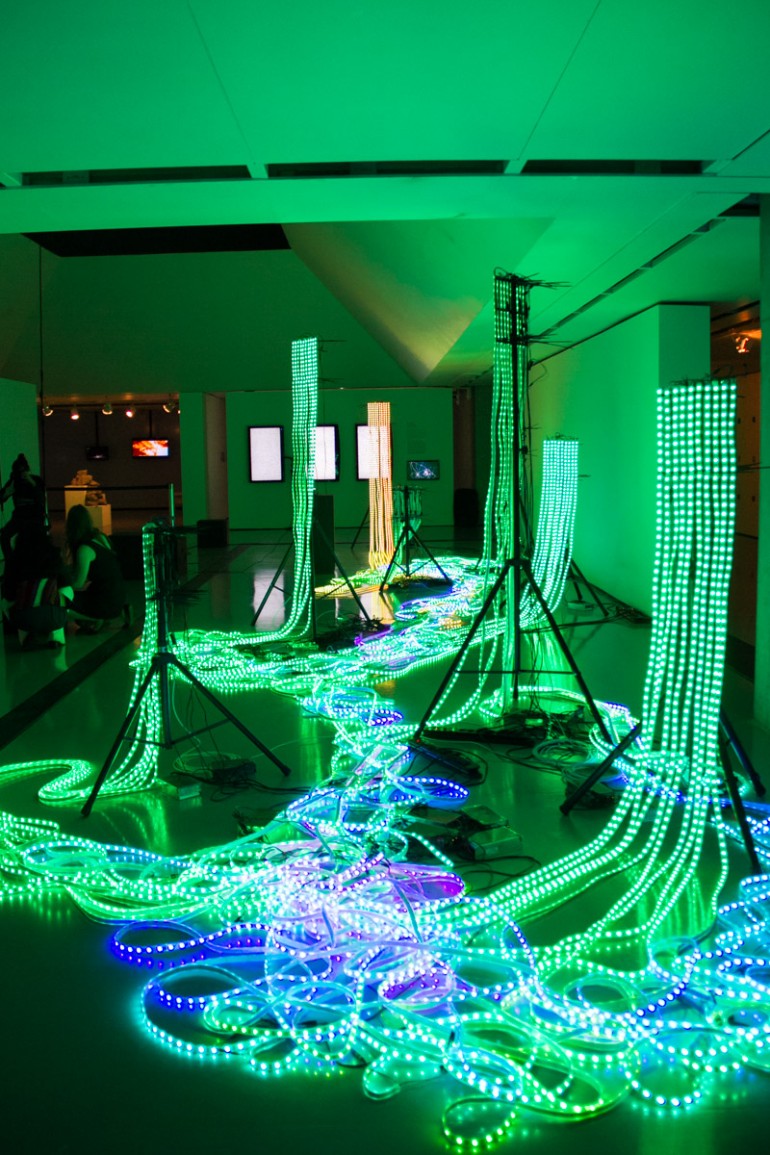
Hardwired
FILE FESTIVAL
“Hardwired” consists of around 18,000 LED-lights that symbolize the transfer of knowledge. Individual luminous pixels connect and then disappear. In a process of constant transformation, new patterns, interrelations and complexities emerge.
.

“Gustave Le Gray No. 1”
In 2019, Ballet Across America was put together with the inspiration of women’s leadership in ballet and dance. To mark the celebration, the Center commissioned choreographer Pam Tanowitz to create a world premiere work for the week’s two participating companies, Dance Theatre of Harlem and Miami City Ballet; both are companies led by visionary women – Virginia Johnson at DTH and Lourdes Lopez in Miami.
Tanowitz set the work on two dancers from each company, with a pianist on stage playing a solo work by the composer Caroline Shaw. The piece had its world premiere during Ballet Across America on May 31, 2019. This video captures the premiere performance.
.
Pianist: Sylvia Jung
Dancers: Renan Cerdeiro, Lauren Fadeley, Anthony Santos and Stephanie Rae Williams

Drawn Together, Held Apart
Caitlin is an artist that is interested in intentional social connection in public spaces. She creates experiences that allow participants to quietly communicate and listen to one another. In the live component of her installation, Caitlin hosts an conversation entitled ‘talking and listening about talking and listening’. ‘Drawn Together, Held Apart’ (2017), a custom made table with inbuilt surface transducer speaker, motion sensor activated LED lighting, proximity speakers and audio. Visitors rest their ears on the glass and listen.
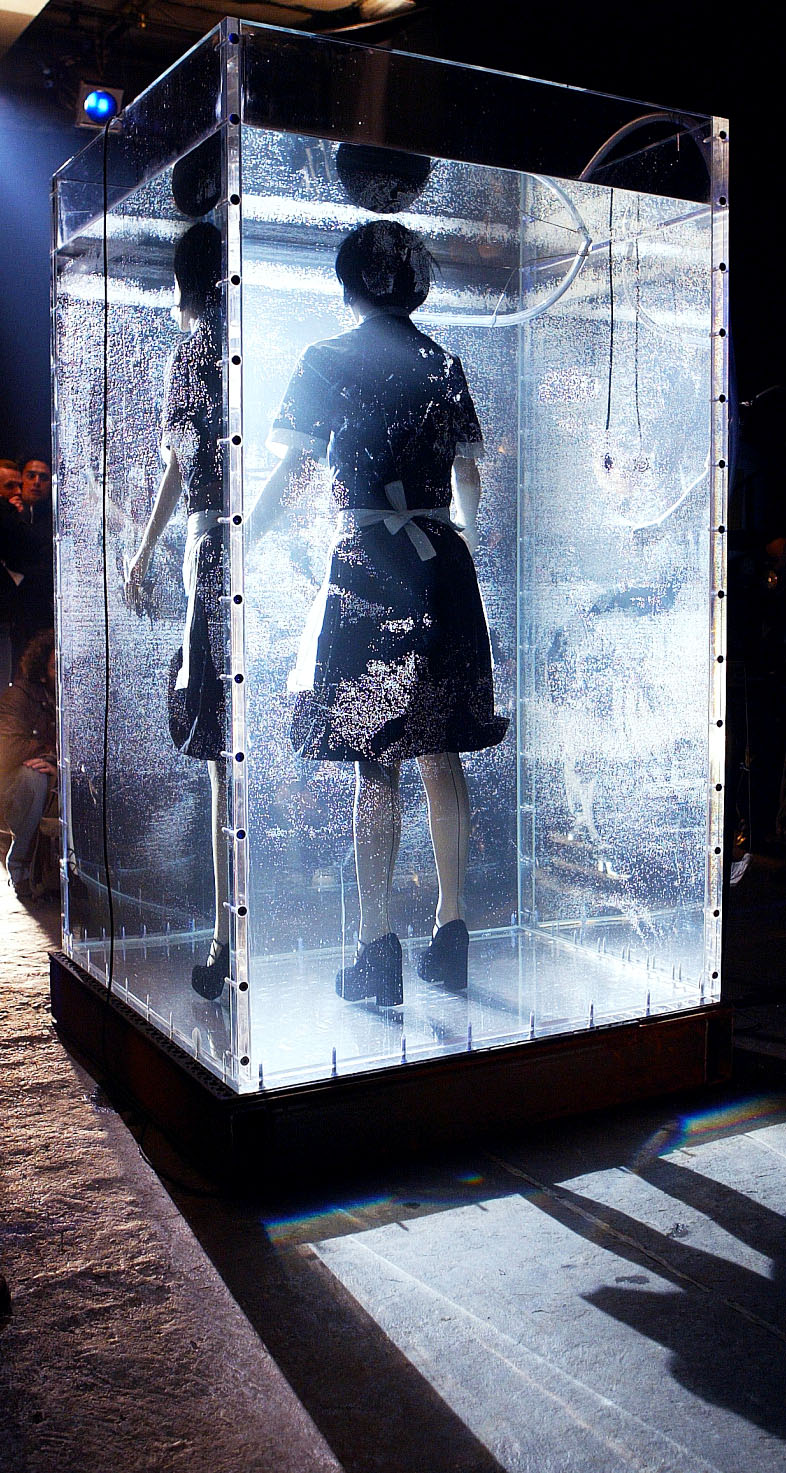
IN
In IN (2003) an actress remains motionless for an hour in a display window filled with water. The distortion to her senses caused by the environment she is in makes her go into a trance. The sounds of her breathing and movement are amplified by microphones.

Noumenon
A truly universal artist, the American Alwin Nikolais (1910-1993) devoted his life to a radical form of staged art he called “dance theater.” Inspired (perhaps unconsciously) by the experiments of Bauhaus members such as Oskar Schlemmer and László Moholy-Nagy in the 1920s, Nikolais devised a style of abstract dance that encompassed costumes, stage sets, choreography, lighting, and music, all under his control. Also in 1963, Nikolais met analog synthesizer pioneer Robert Moog, who was at the time just starting his business in New York. He was fascinated by the sounds of Moog’s machines, and with the money provided by a a Guggenheim Fellowship, Nikolais bought the first ever commercially produced Moog synthesizer. It was the primary sound-source for all of Nikolais’ scores from 1963 to 1975. The instrument is now housed at the Stearns Collection of Musical Instruments at the University of Michigan in Ann Arbor.

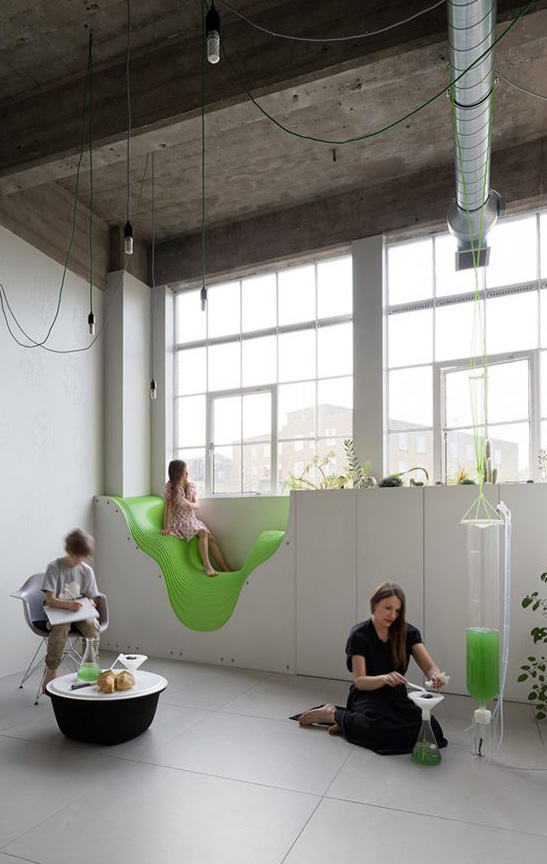
BioBombola
The Coral
Home Algae Garden
In June 2020 ecoLogicStudio has devised BioBombola, a pioneering project that invites individuals, families and communities to cultivate a domestic algae garden – a sustainable source of vegetable proteins. BioBombola absorbs carbon dioxide and oxygenates homes more effectively than common domestic plants while fostering a fulfilling daily interaction with nature. Each BioBombola is composed of a single customized photobioreactor, a one metre tall lab grade glass container, filled with 15 litres of living photosynthetic Spirulina strain and culture medium with nutrients.

Formalidade Cerimonial
O trabalho de Frederik Heyman é um ato de equilíbrio que incorpora várias mídias – incluindo vídeo, instalações e fotografia – muitas vezes em um ambiente digitalmente alterado. Em seu trabalho, Heyman explora a memória e a duração, usando fotogrametria e digitalização 3D para retratar e representar a passagem do tempo. As marcas registradas do trabalho de Heyman são mecânicas e tecnológicas: fios, rodas, letreiros LED de rolagem, armações de metal, pinças, lâmpadas industriais, telas e câmeras. Corpos – ao contrário dos humanos – estão sujeitos a uma dinâmica incomum com essas armadilhas tecnológicas. Em Cerimonial Formality (2020), uma contorcionista está presa em uma gaiola de metal enquanto um espectador, preso a fios, observa.
.
Zeremonielle Formalität Frederik Heymans Arbeit ist ein Balanceakt, der mehrere Medien einbezieht – darunter Video, Installationen und Fotografie – oft in einer digital veränderten Umgebung. In seiner Arbeit erforscht Heyman Gedächtnis und Dauer, indem er Photogrammetrie und 3D-Digitalisierung verwendet, um den Lauf der Zeit darzustellen und darzustellen. Die Markenzeichen von Heymans Arbeit sind mechanisch und technologisch: Drähte, Räder, scrollende LED-Schilder, Metallrahmen, Pinzetten, Industrielampen, Bildschirme und Kameras. Körper unterliegen bei diesen technologischen Fallstricken – anders als der Mensch – einer ungewöhnlichen Dynamik. In Ceremonial Formality (2020) ist ein Schlangenmensch in einem Metallkäfig gefangen, während ein kabelgebundener Zuschauer zuschaut.

Mens SS 2020
“After the scene shifted from a selection of 2D garments, removed to reveal Browne’s brilliant designs below, the show began in earnest. The looks, as gleefully playful as ever, took on elements of Browne’s typical offerings and elevated them to the level of supreme costume design. Several imposing silhouettes recalled dresses worn by Antoinette-era aristocracy, with gargantuan trousers and shapely sportcoats crafted to resemble distorted Ivy League staples. Elsewhere, pleated skirts emerged as a prime trouser replacement, with cropped jackets and seersucker jockstraps to introduce a sporty motif.” Jake Silbert

‘SnP’, 2018, recycled plastic, injection moulded
“Widrig’s art breaks down the boundaries between disciplines; borrowing tools traditionally associated with one industry and using them in other fields, in often unanticipated and exciting ways. Widrig uses computer simulation processes and advanced technologies adopted from the special effects business to create sculptural 3D-printed craftwork—digital designs materialize into intricate sculptures in glass or recycled plastic and furniture pieces with impeccable undulated thin surfaces,” Devid Gualandris

Hibanana Studio
Liu Chang & Miao Jing
FILE SAO PAULO 2017
FILE LED SHOW
“INFINITE” is an audiovisual installation created by New York-based visual artist duo Liu Chang and Miao Jing, in collaboration with sound artist Gan Jian. “INFINITE” explores the connection between time and space, discusses about spatial gravity and its influence to human’s perception. Sound and visual elements are in completely in sync in order to contribute the immersive experience.

EYJAFJALLAJÖKULL
Inspired by the icelandic volcano, which wreaked travel havoc across europe, Joanie Lemercier presents the latest incarnation of its audiovisual mapping project painted directly onto a large wall, a wireframed scenery is slowly revealed by gentle light effects. The audience’s sense are progressively challenged as optical illusions question their perception of space.

Ciel Électrique
Une gigantesque installation ELECTRIC SKY composée de 640 lumières LED Winch XS et Sphere 17 a été créée par KINETIC LIGHTS pour une performance scénique épique en 2047 Apologue dirigée par ZHANG Yimou et produite par L!VE Kingway au National Center for the Performing Arts de Pékin. ZHANG Yimou brise la forme des pièces de théâtre traditionnelles, combinant les arts folkloriques chinois avec la technologie internationale, et créant ainsi une « performance conceptuelle » unique. Les arts populaires chinois ont été présentés avec différentes technologies de pointe, déclenchant une nouvelle vitalité. Notamment, 20 équipes et individus de sept pays se sont réunis dans cette performance.